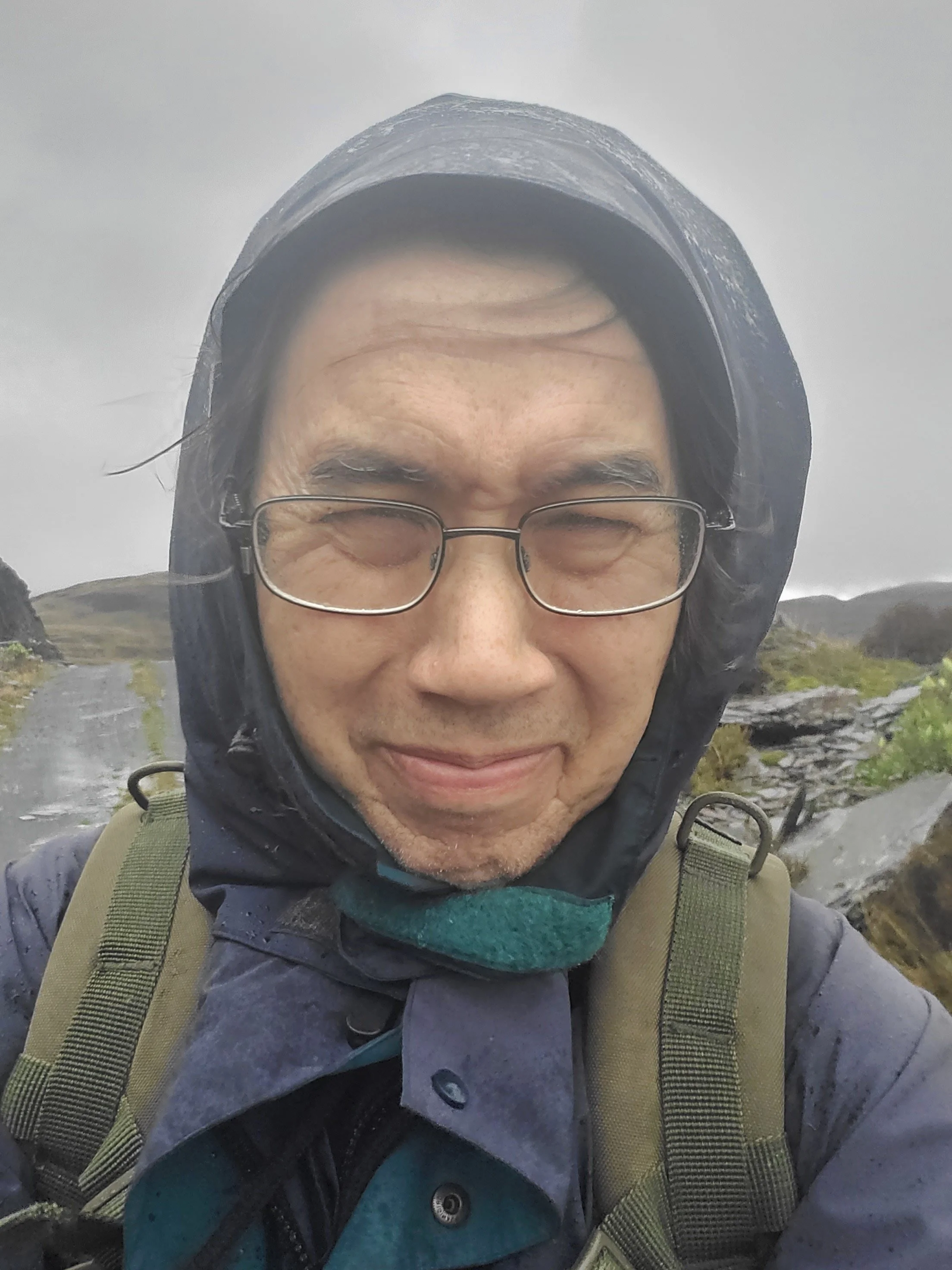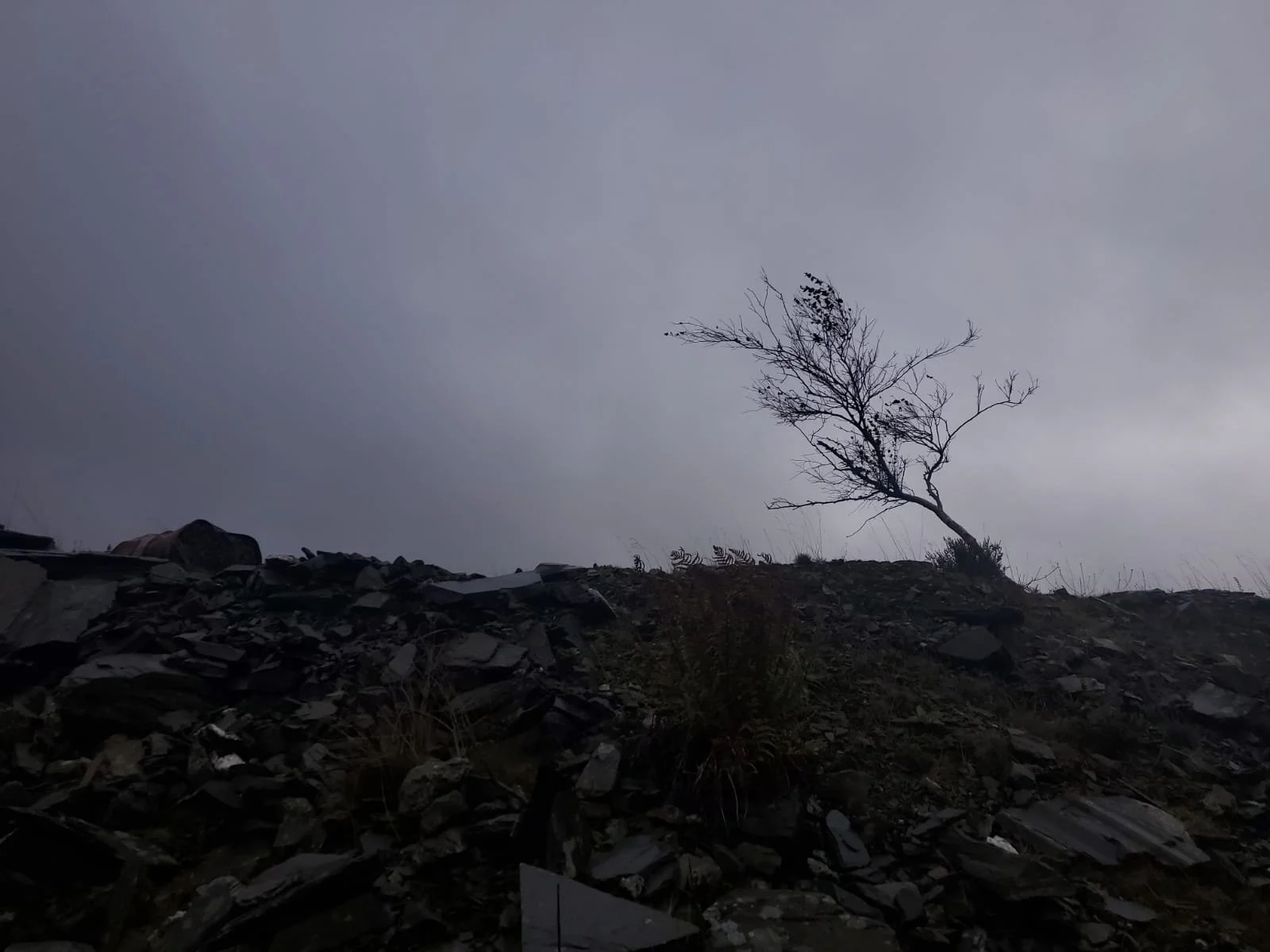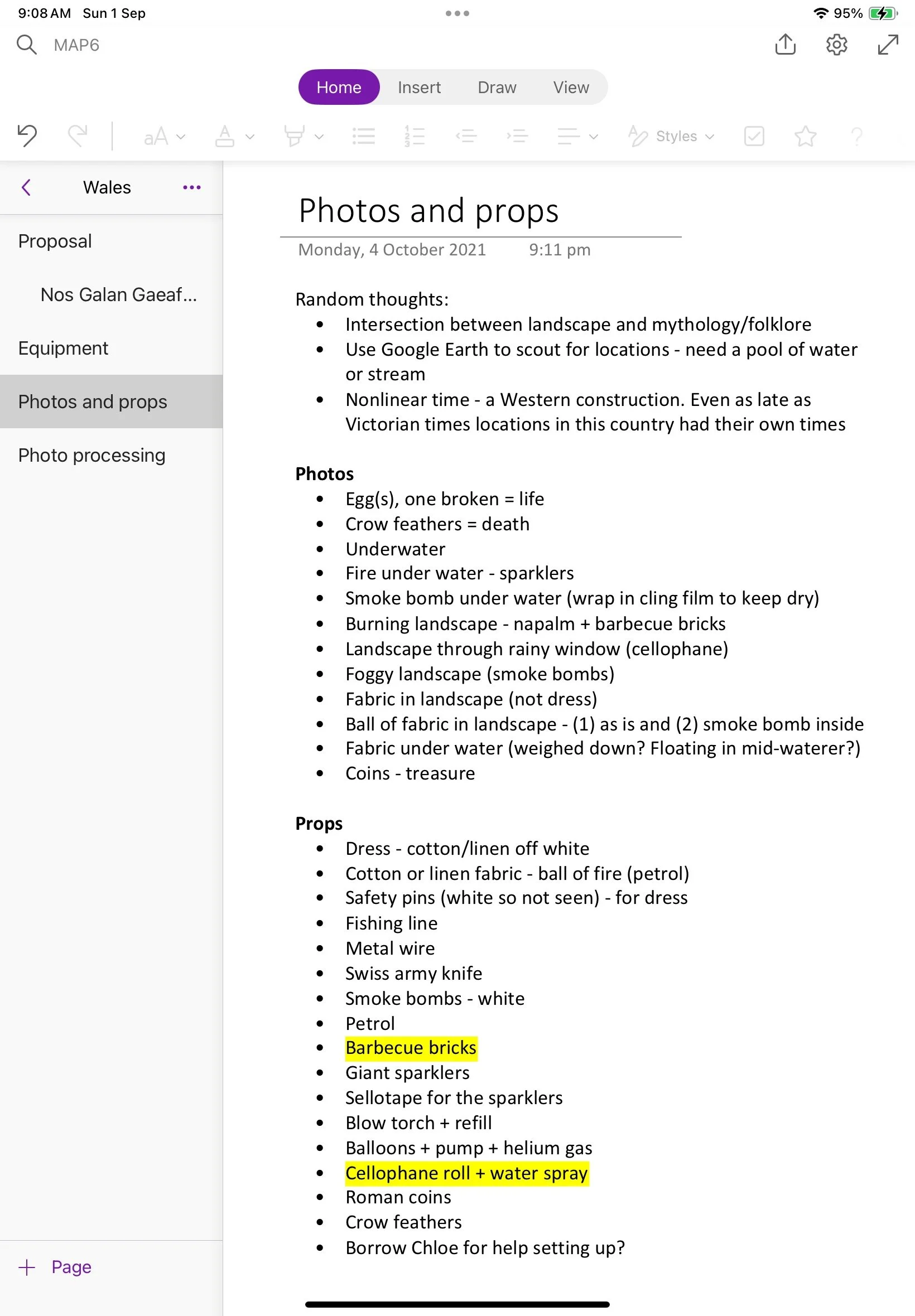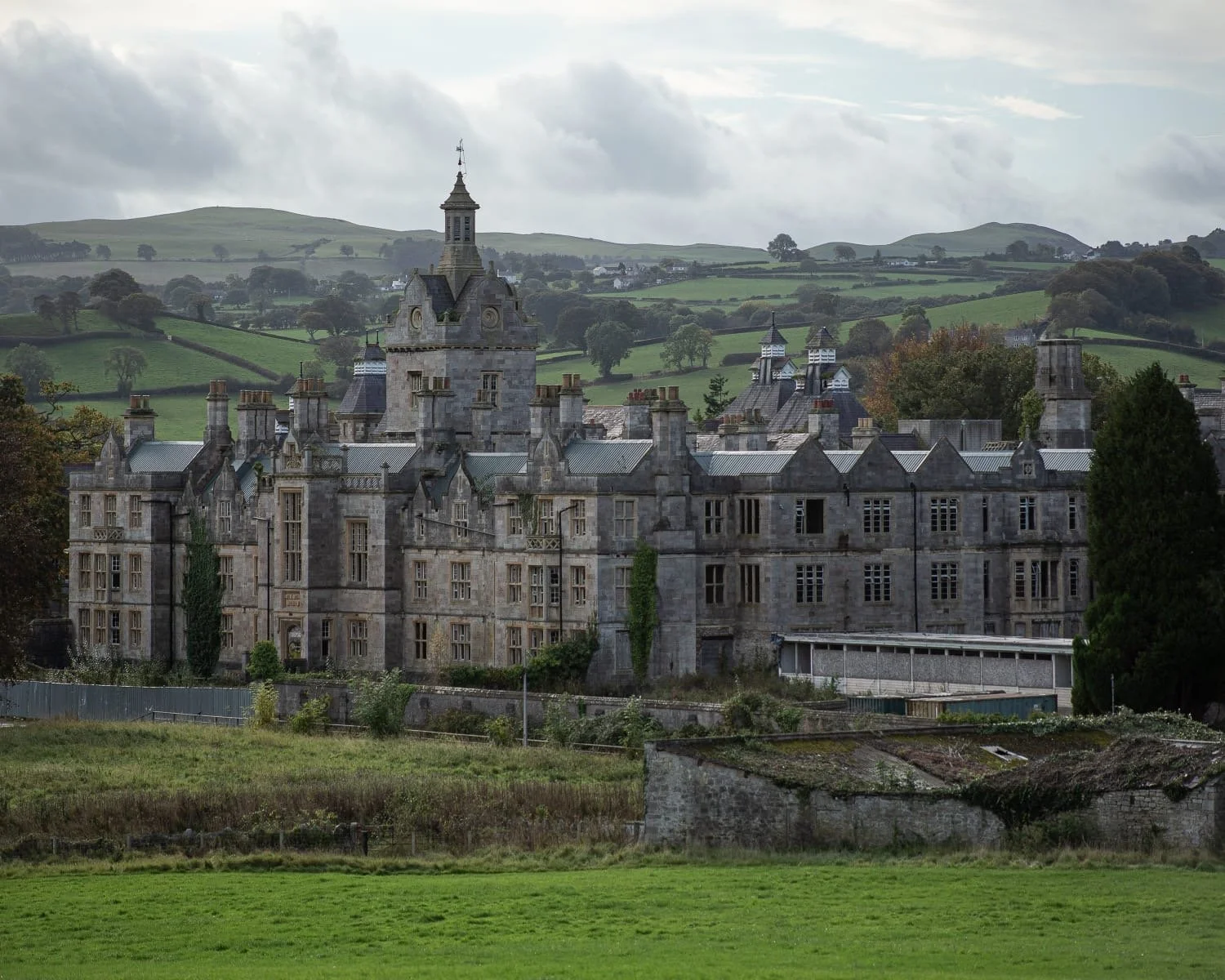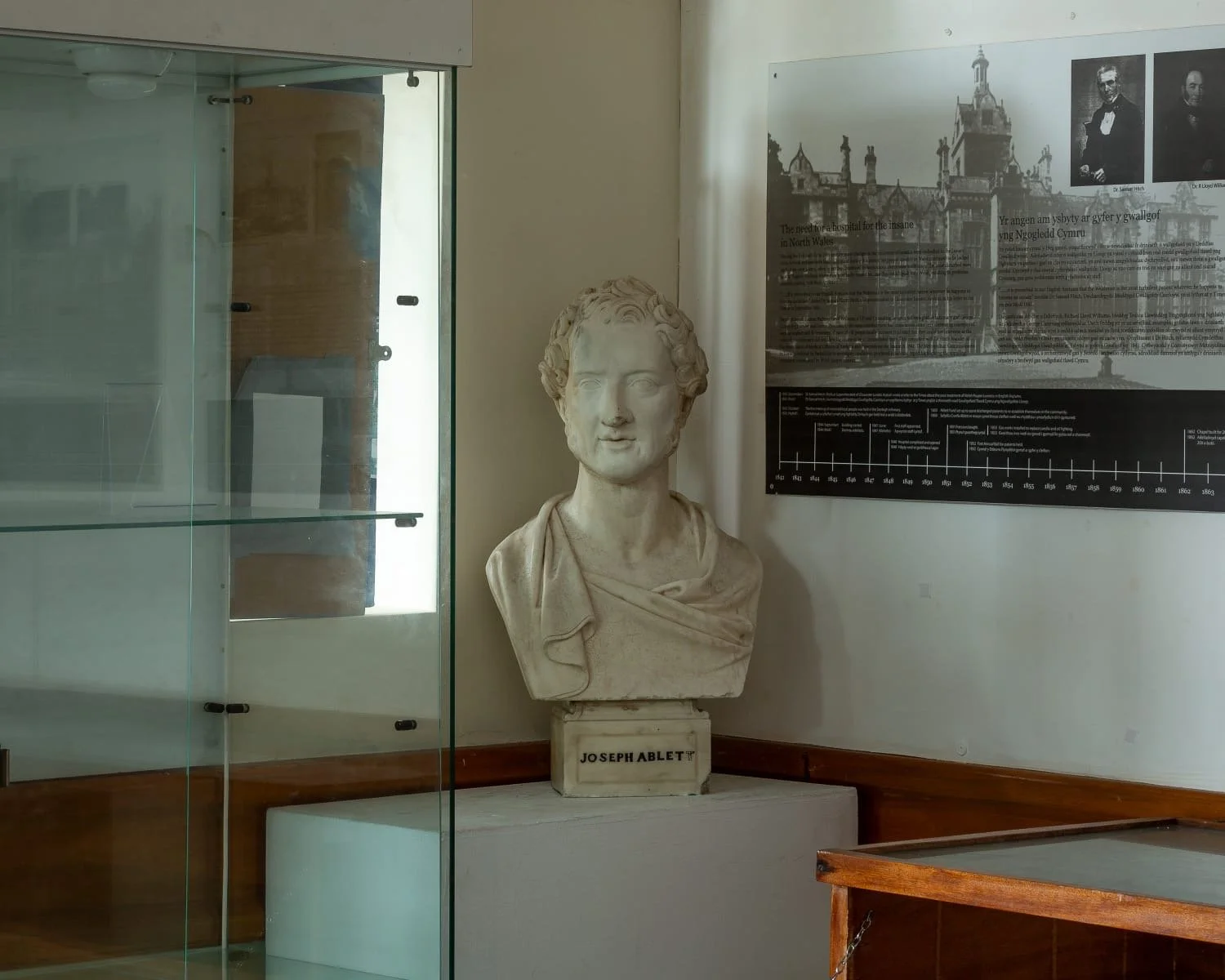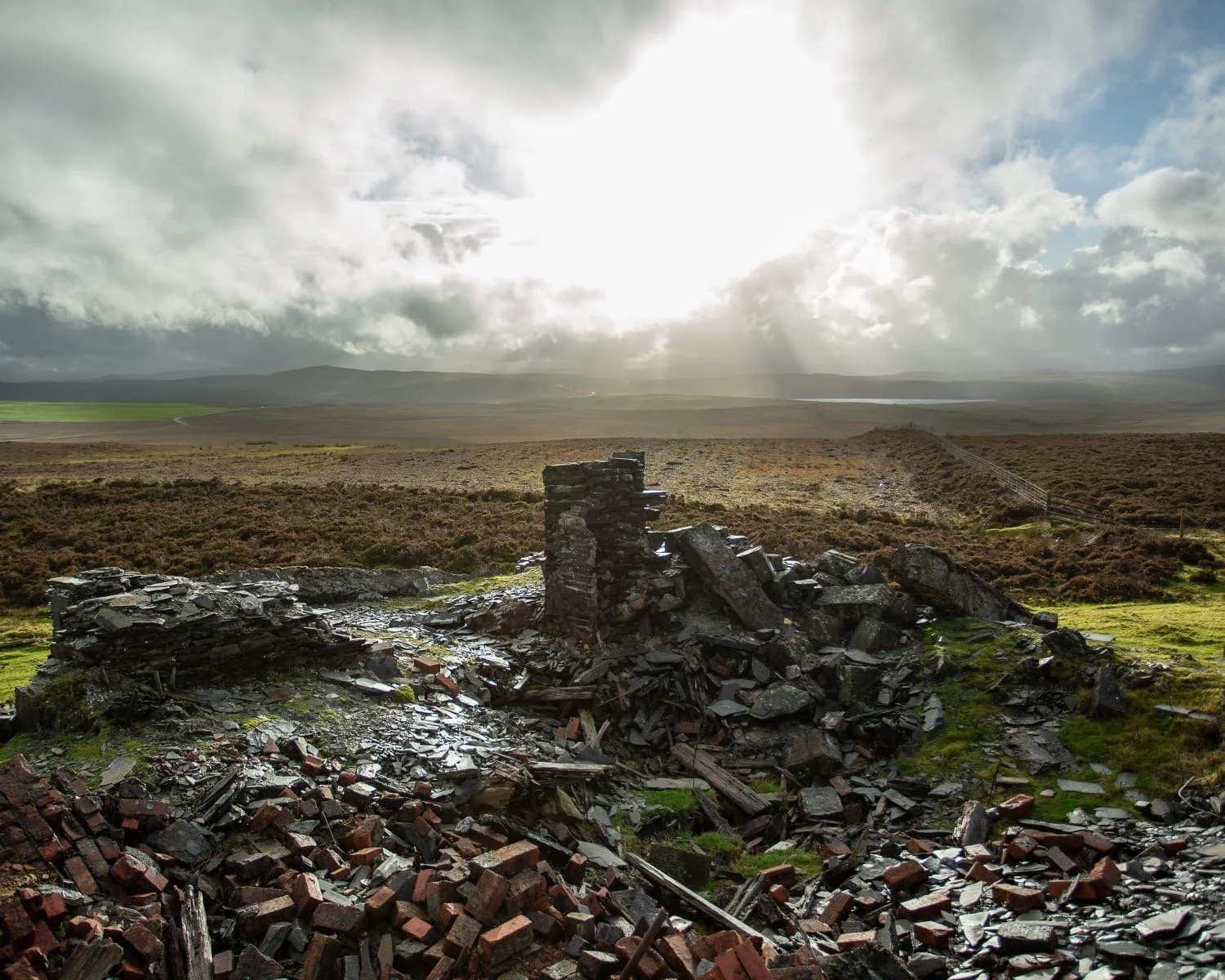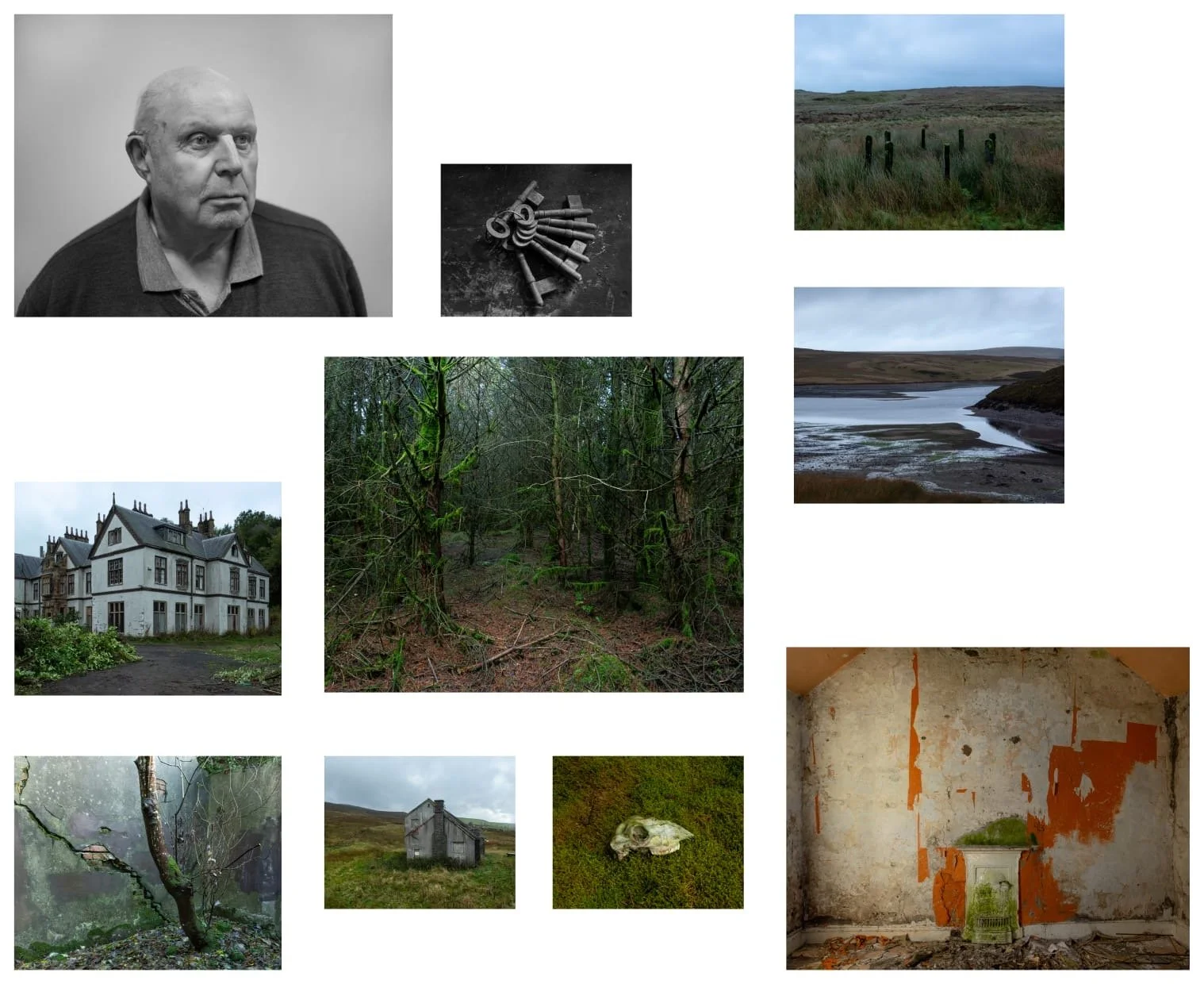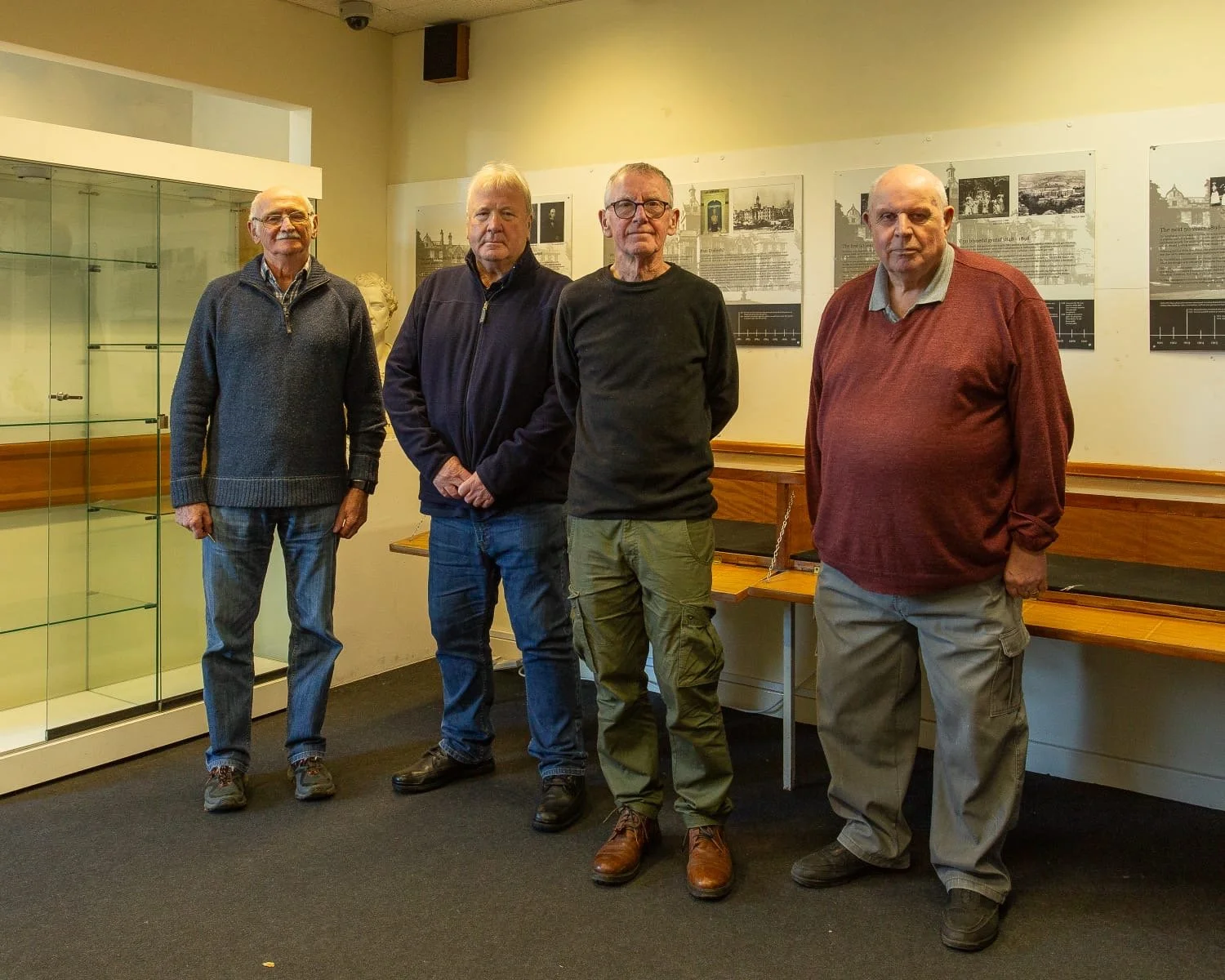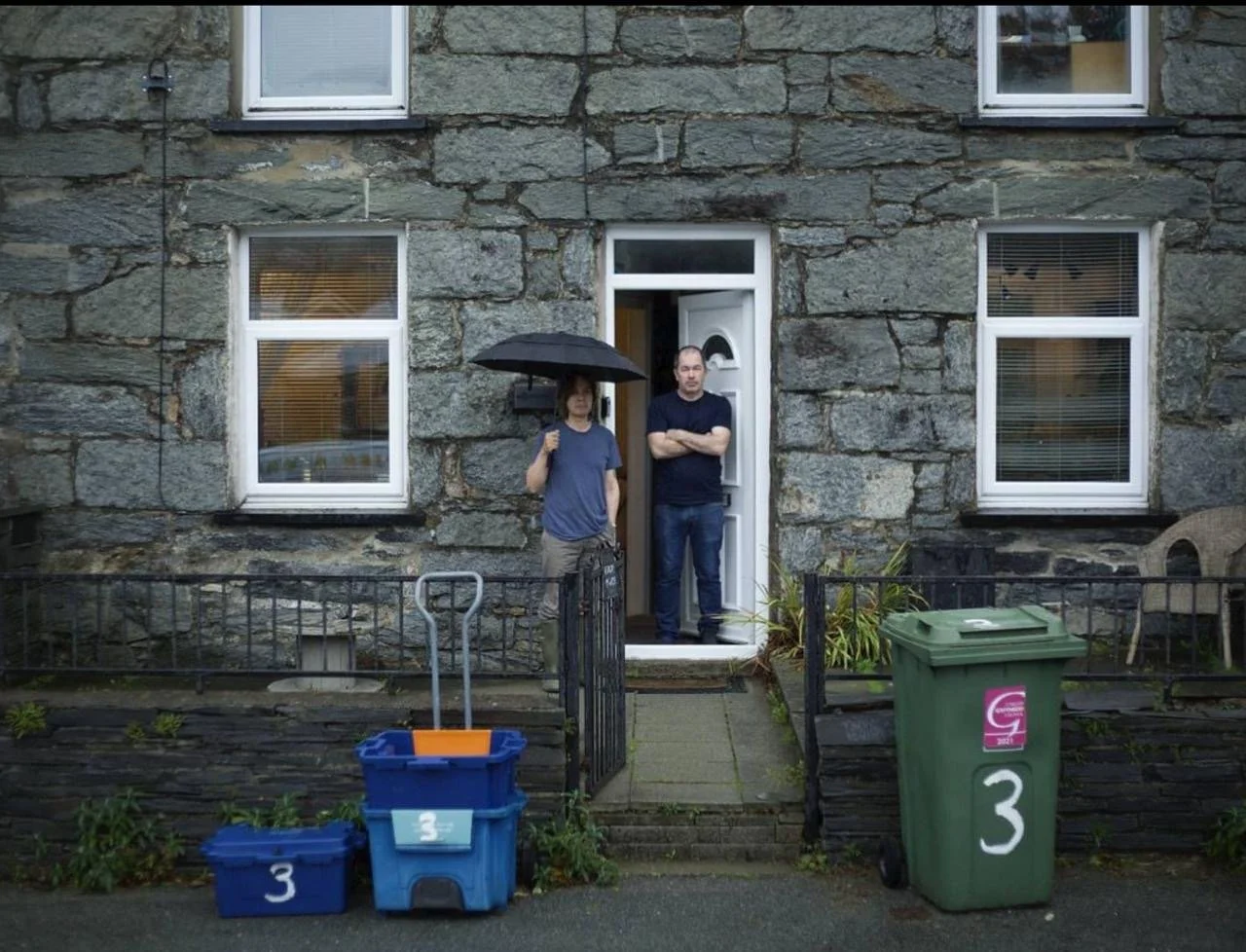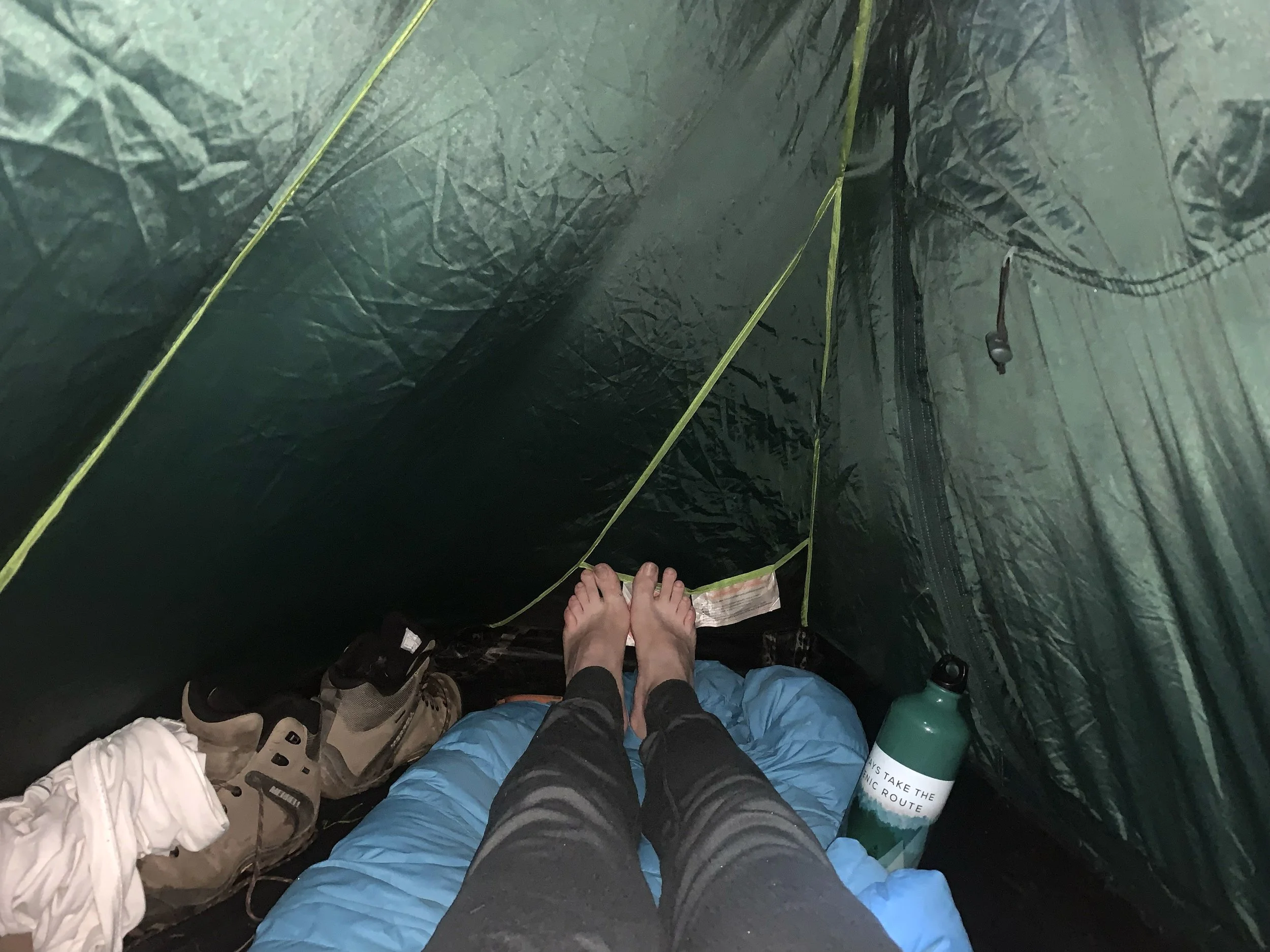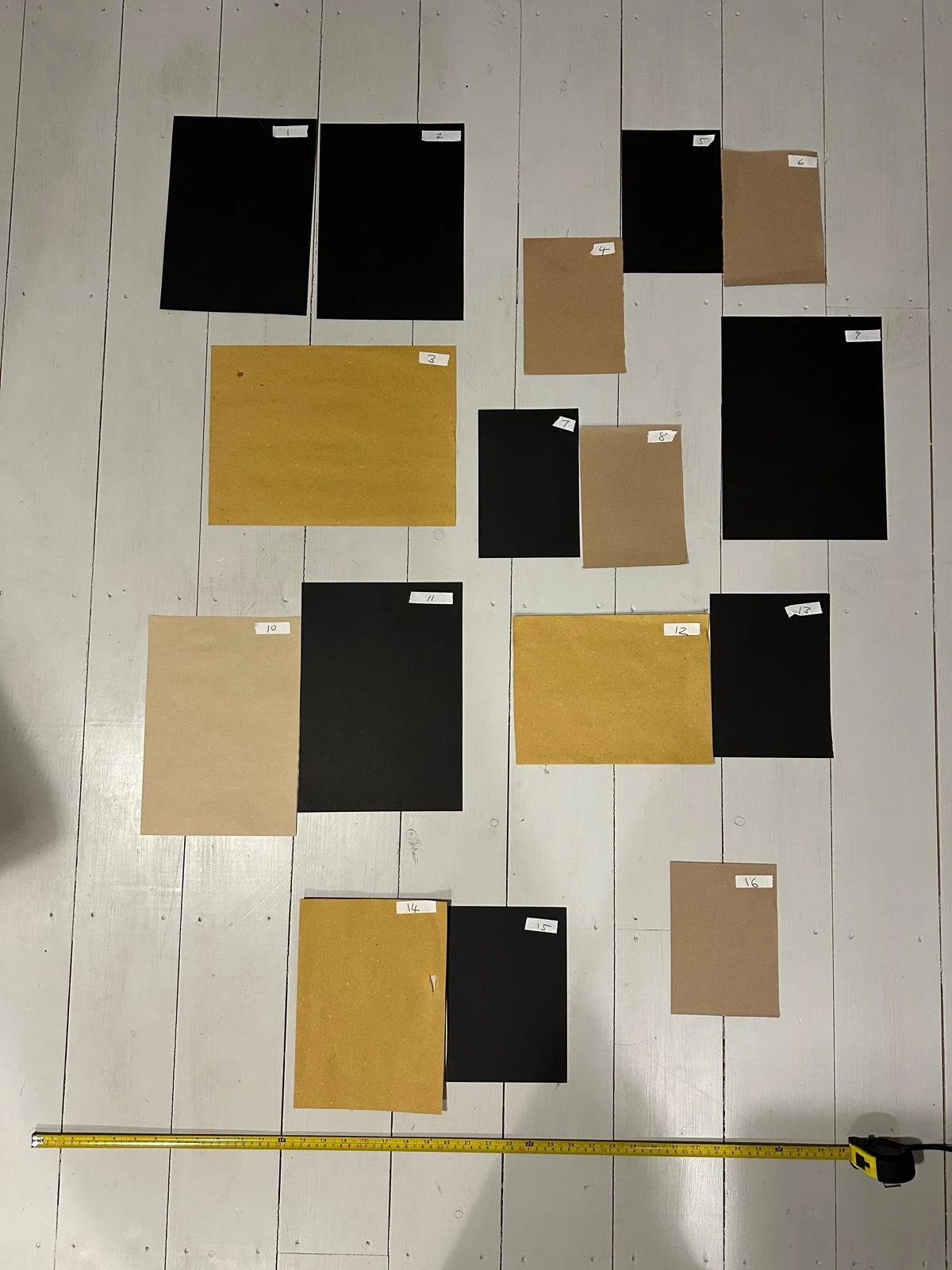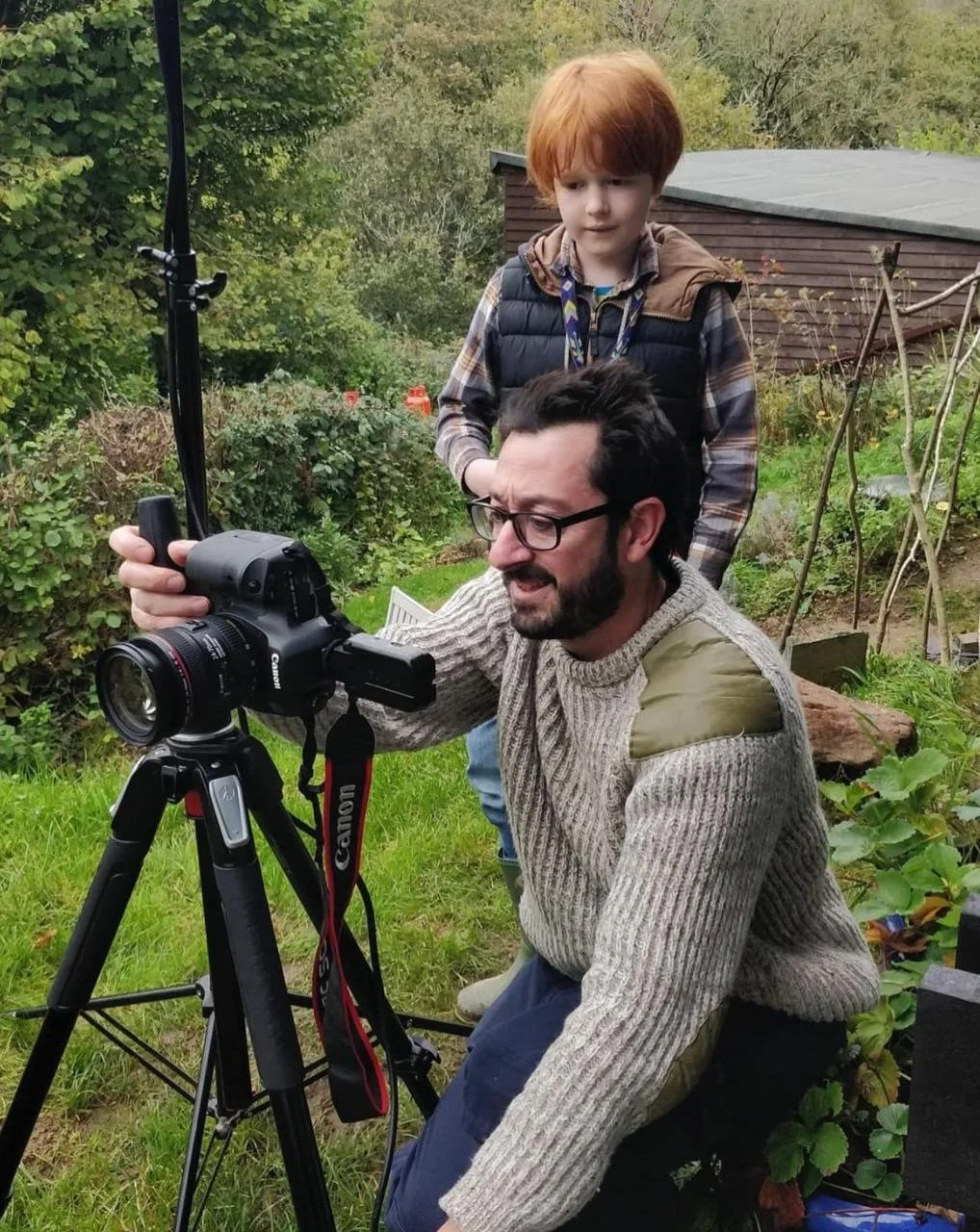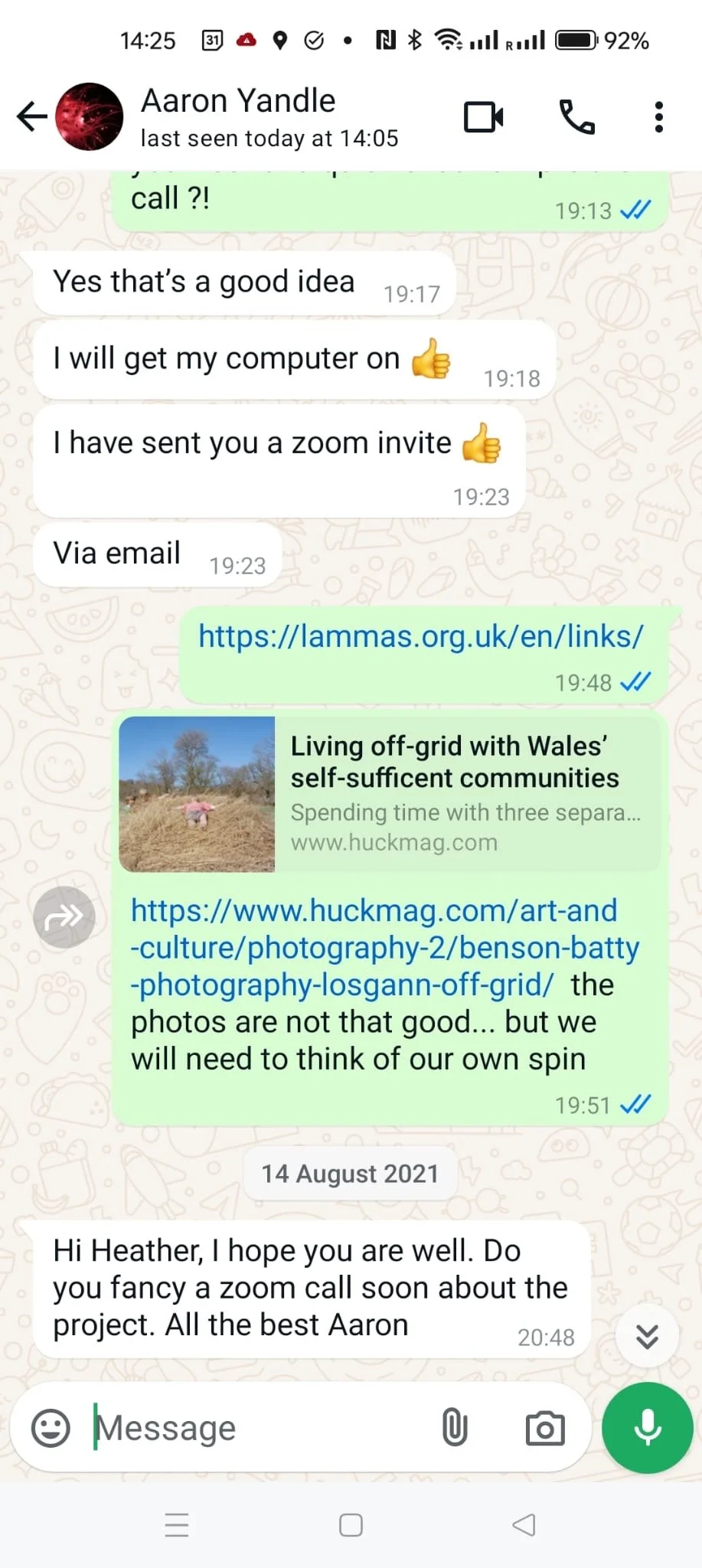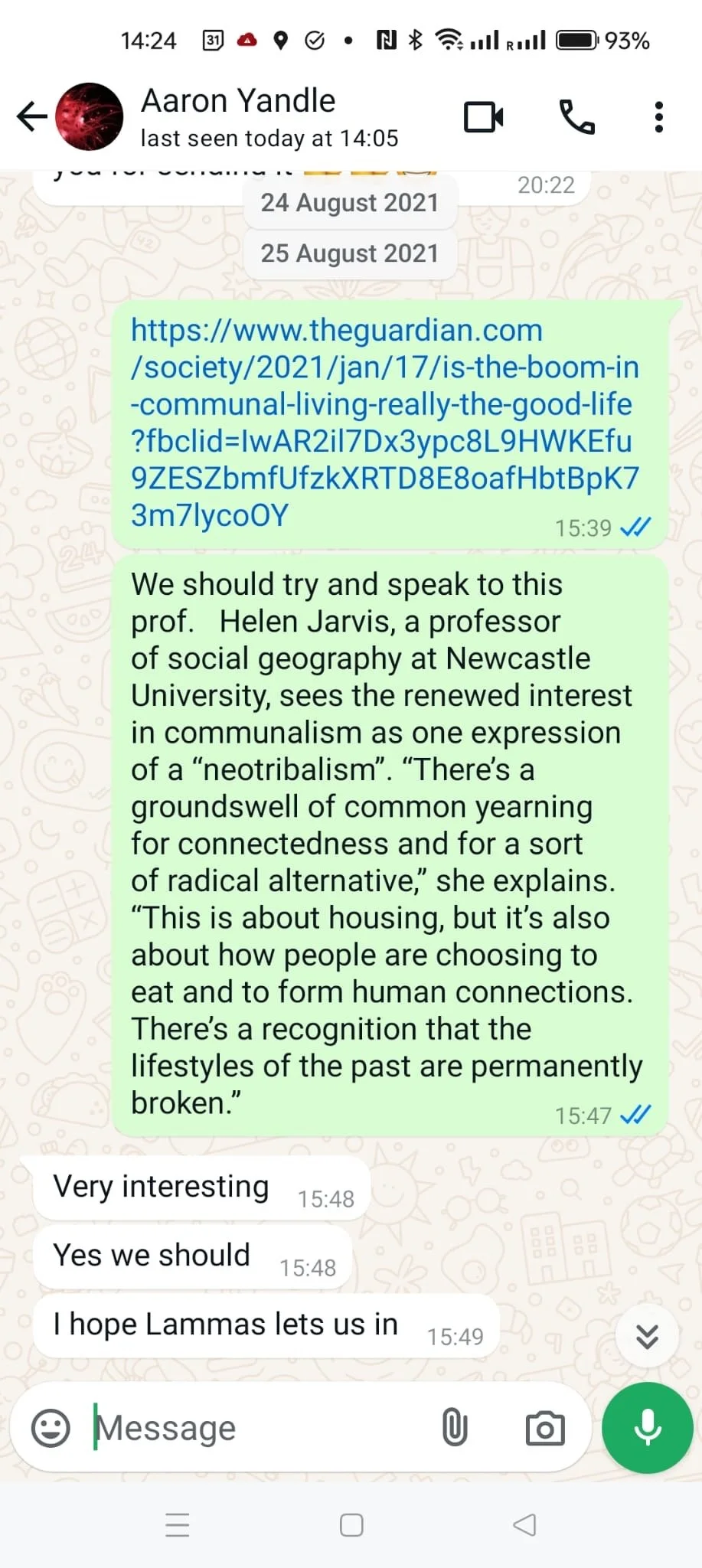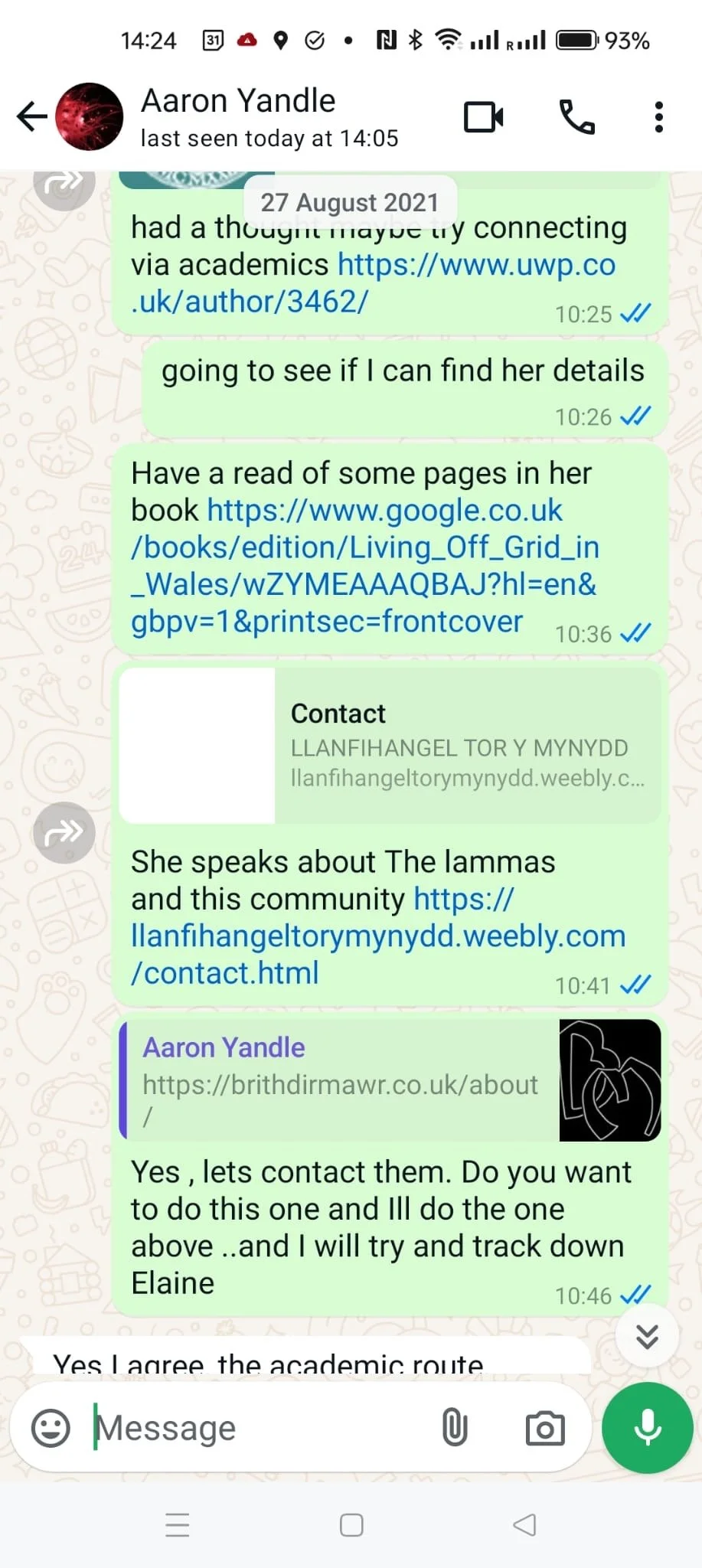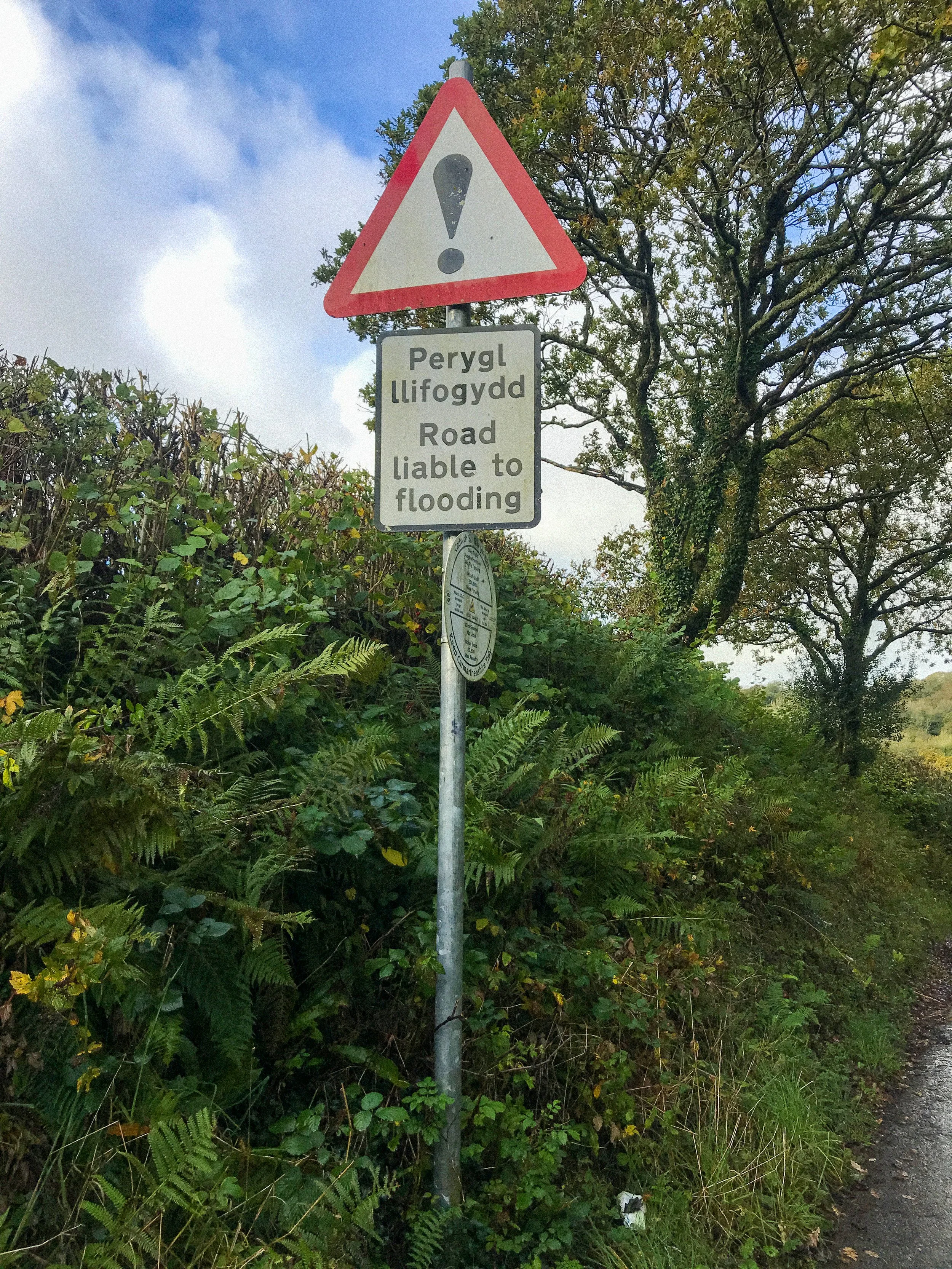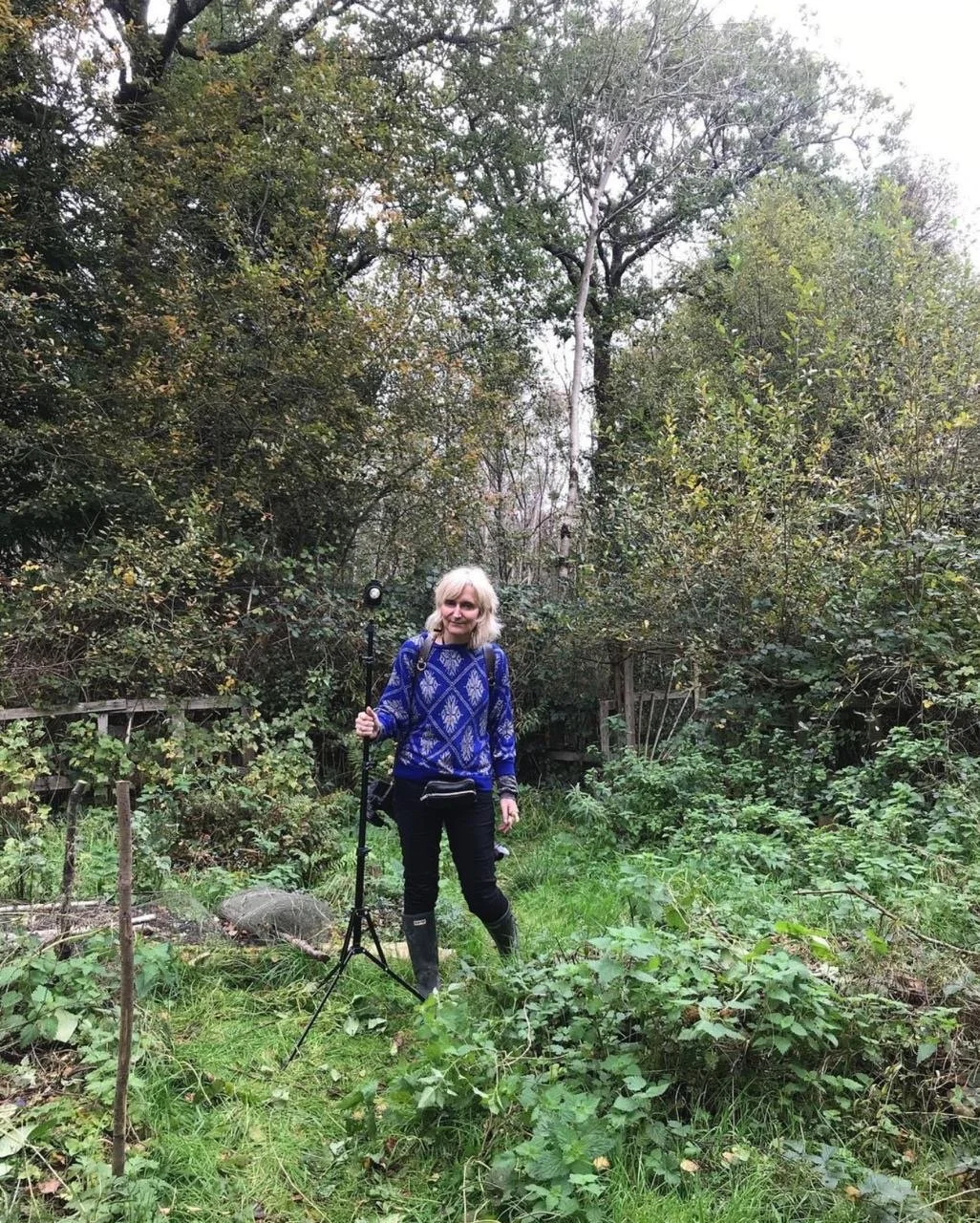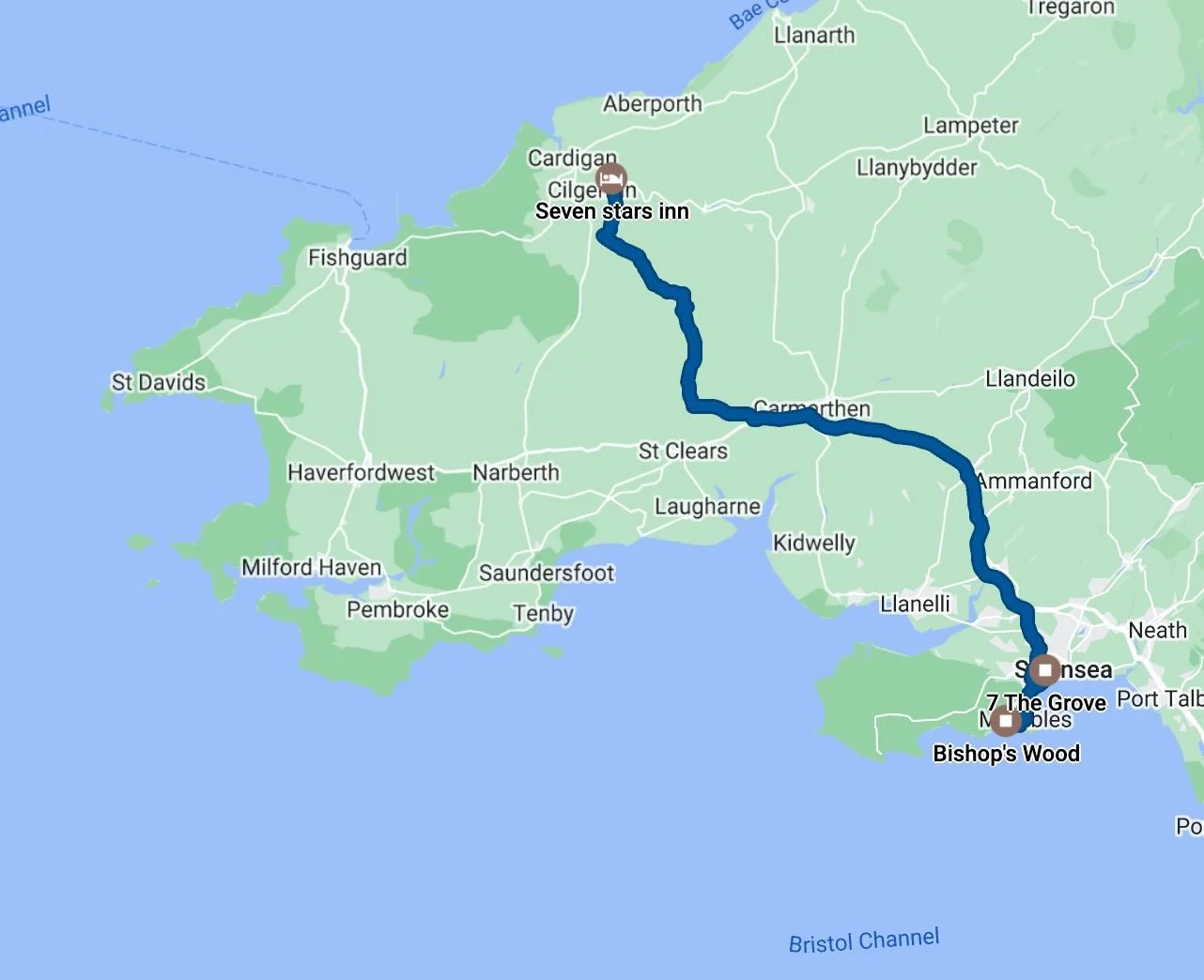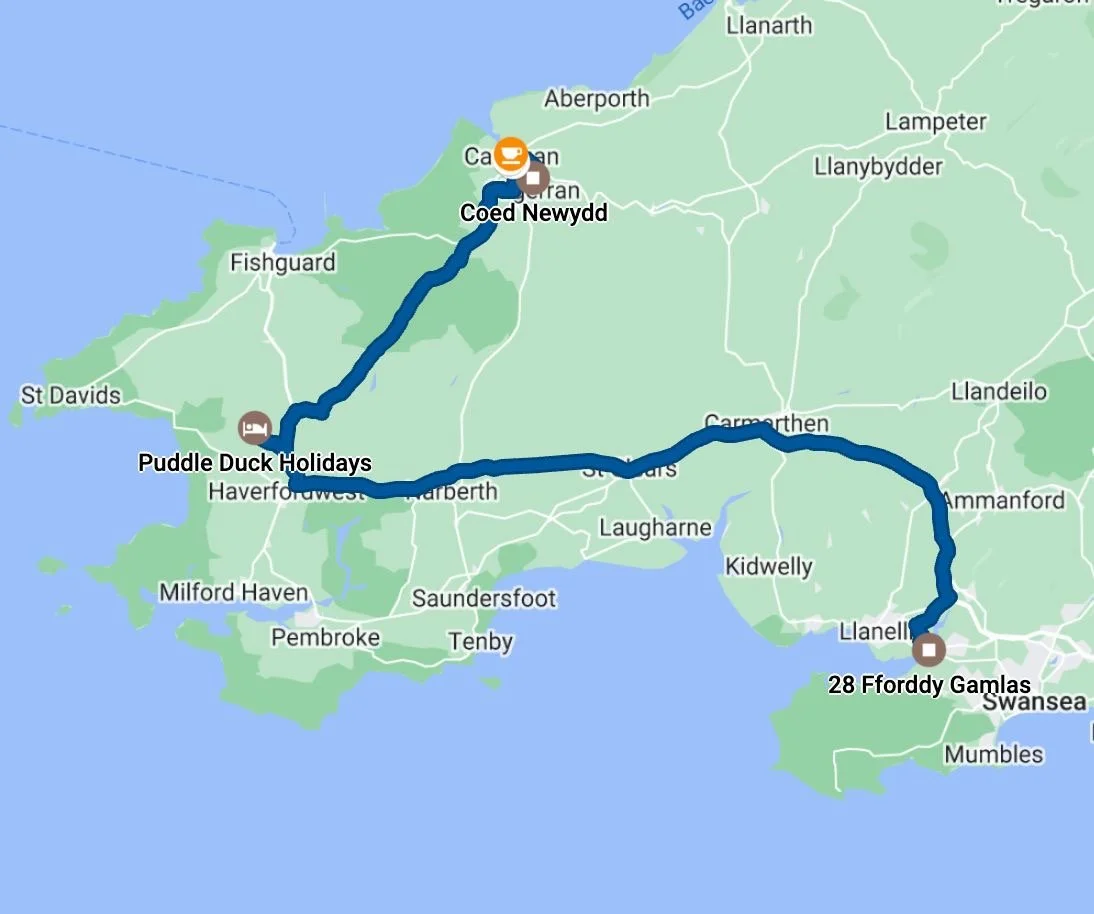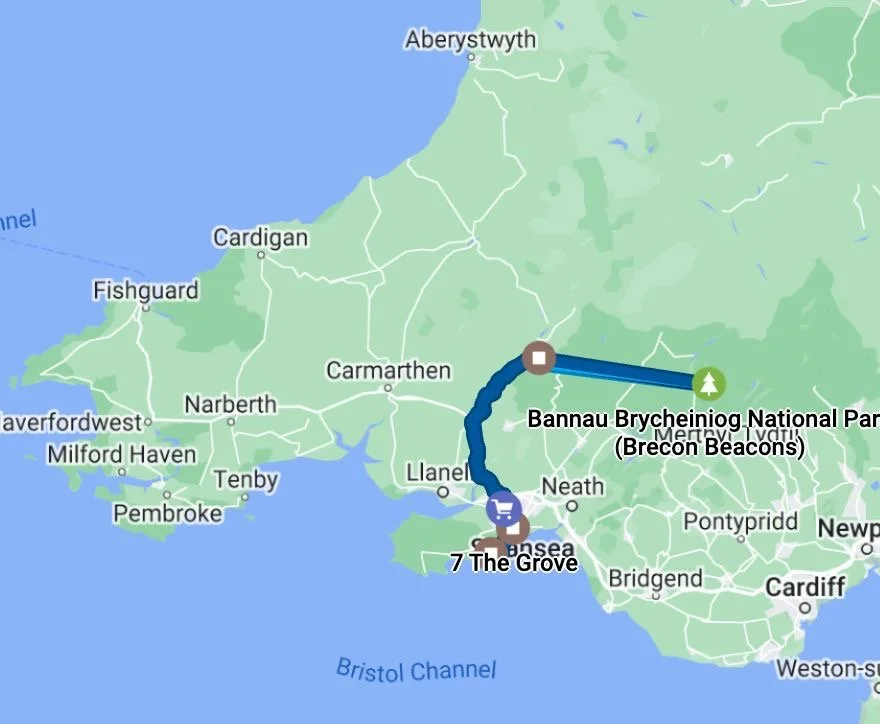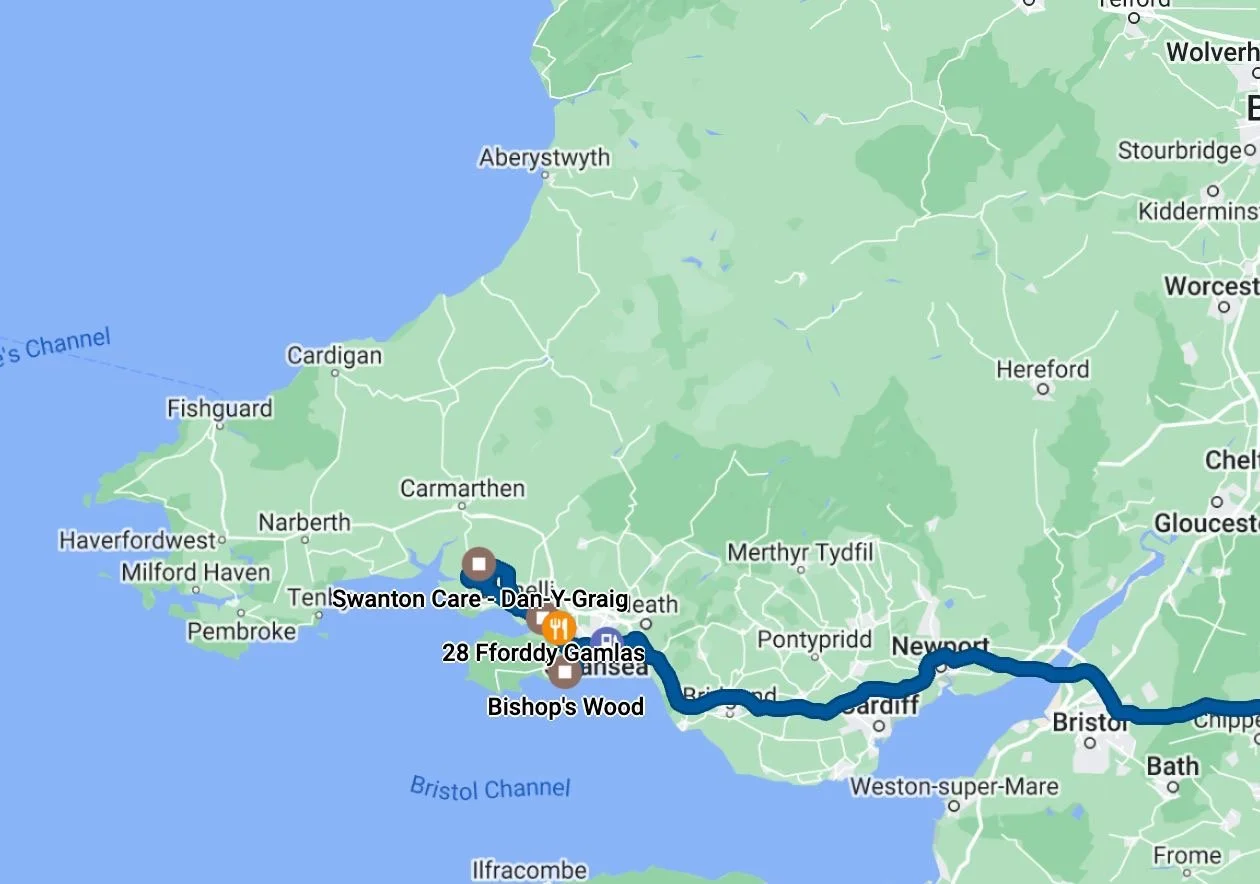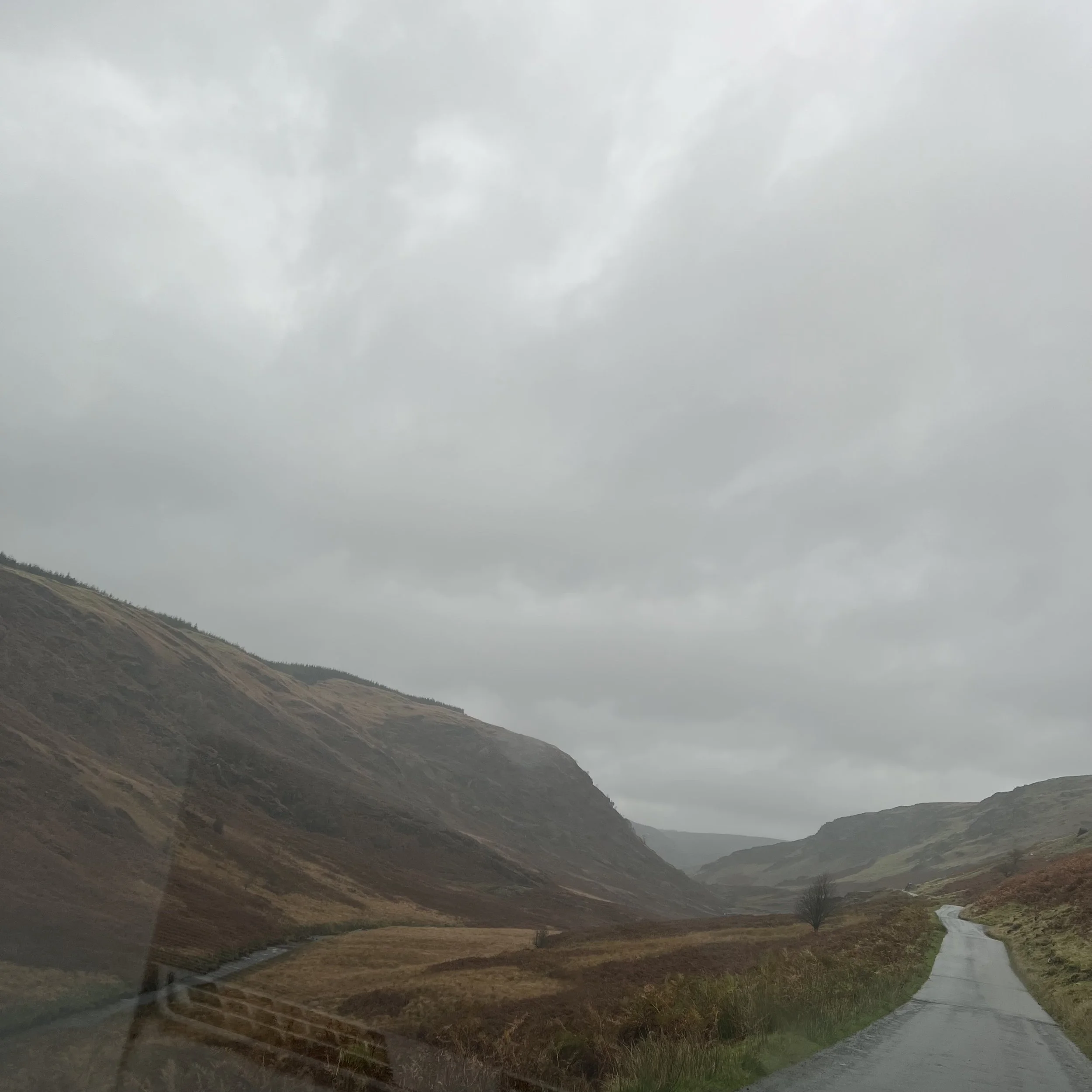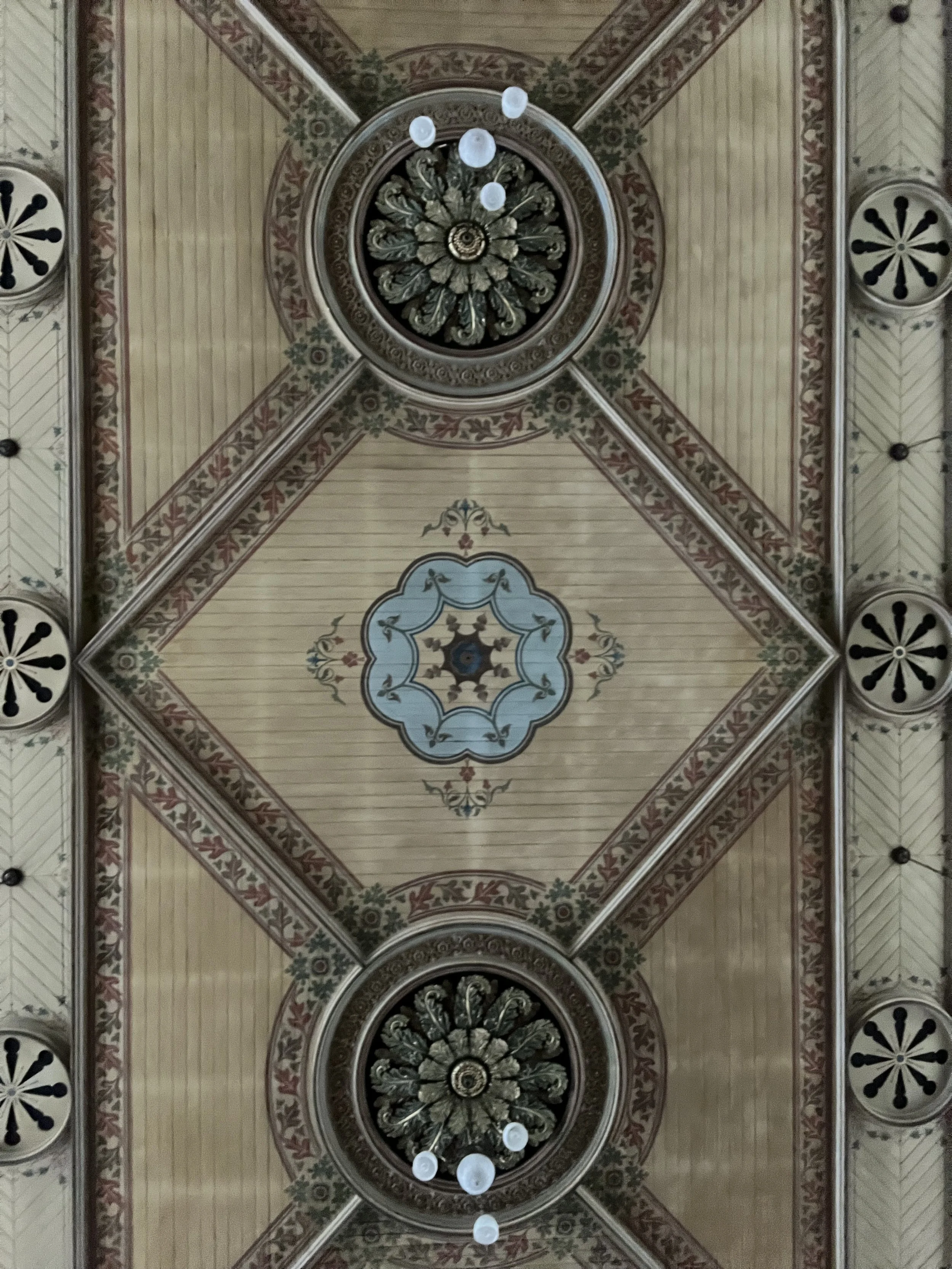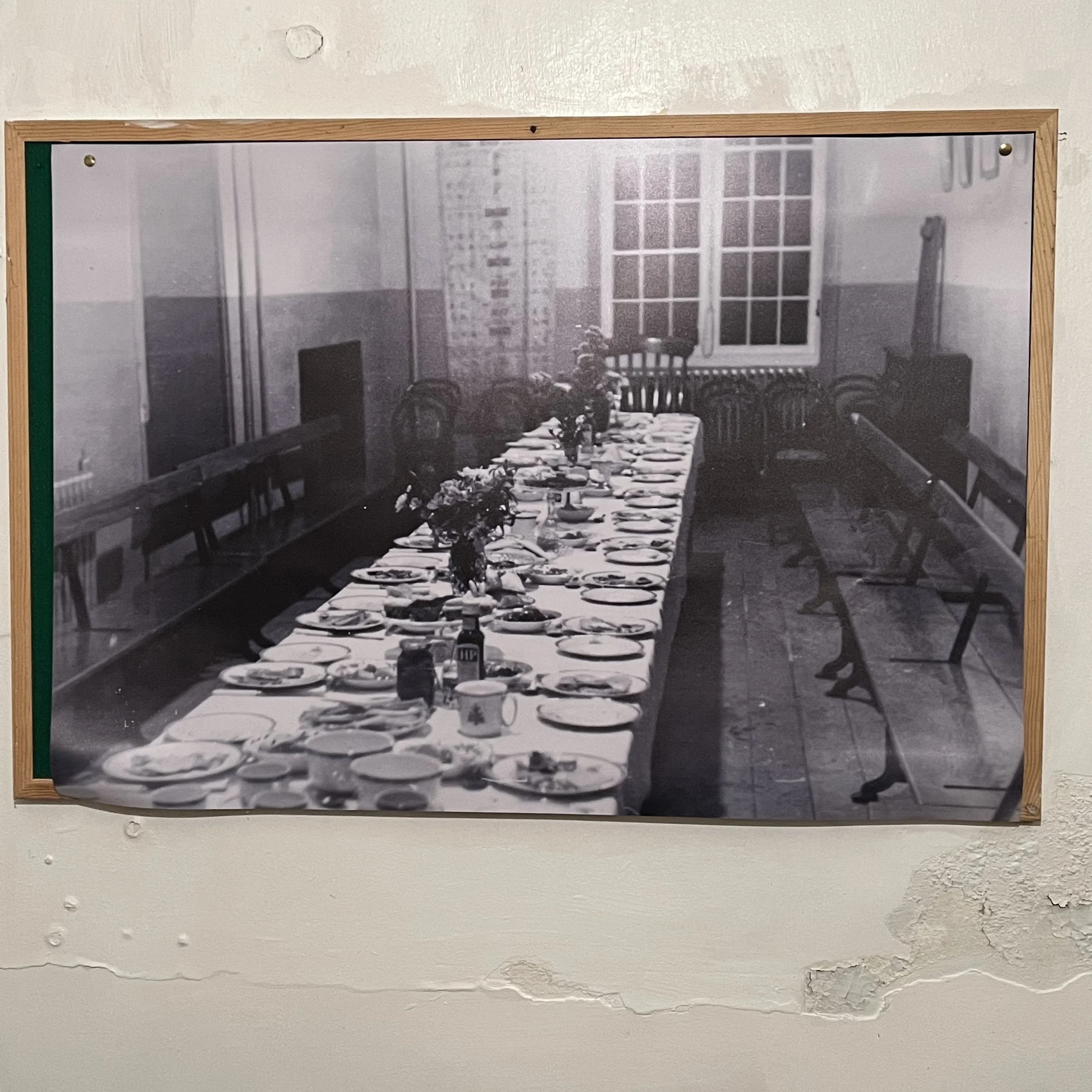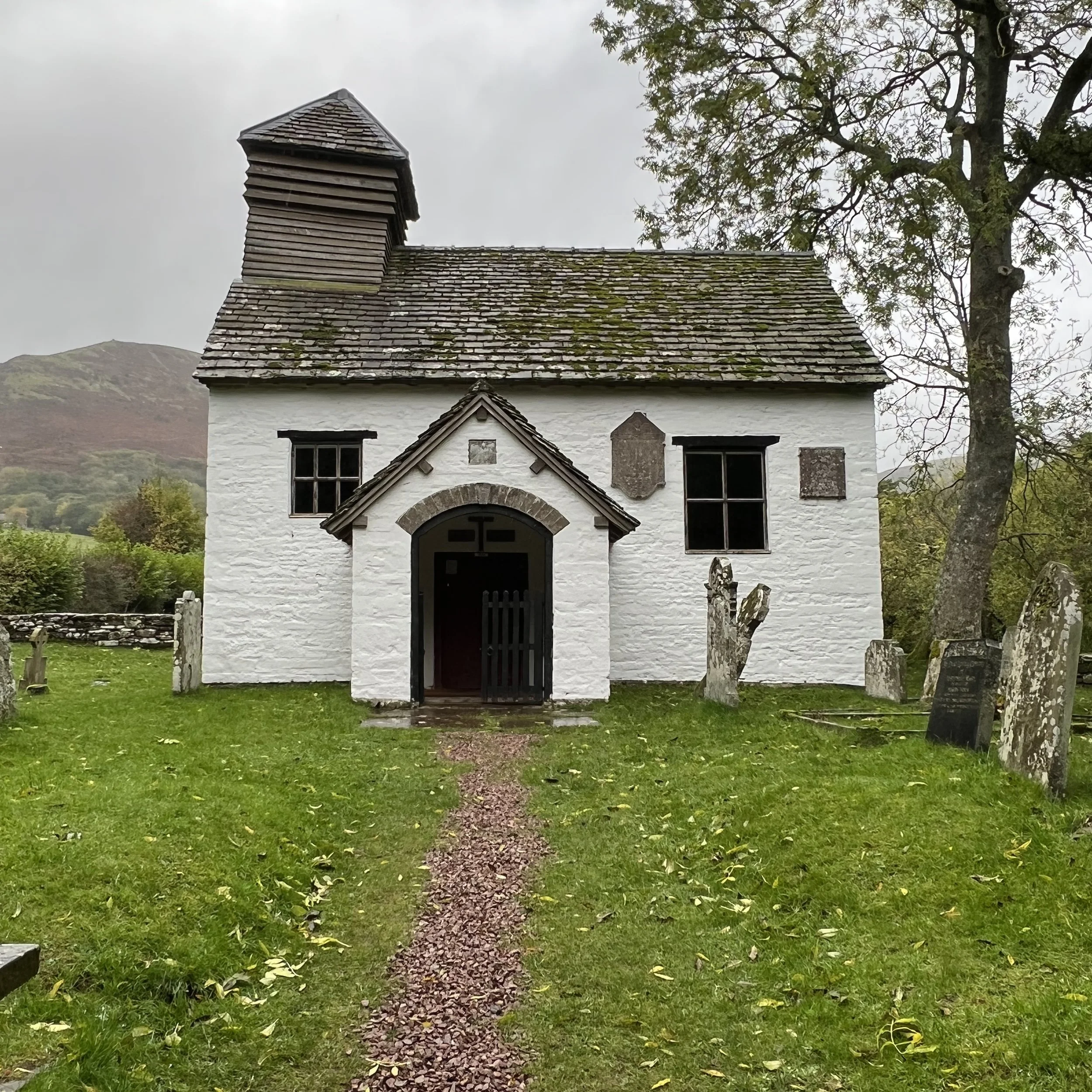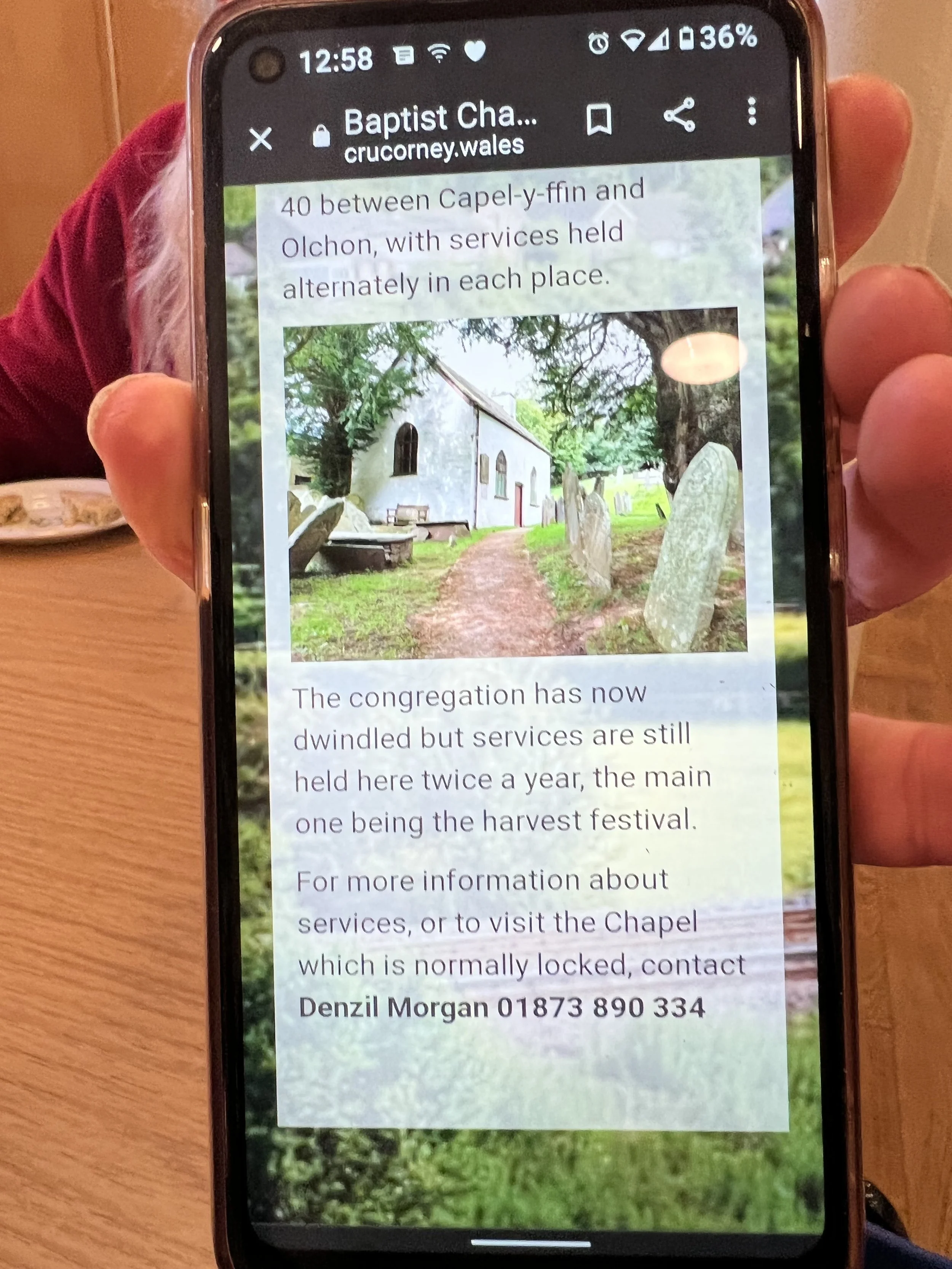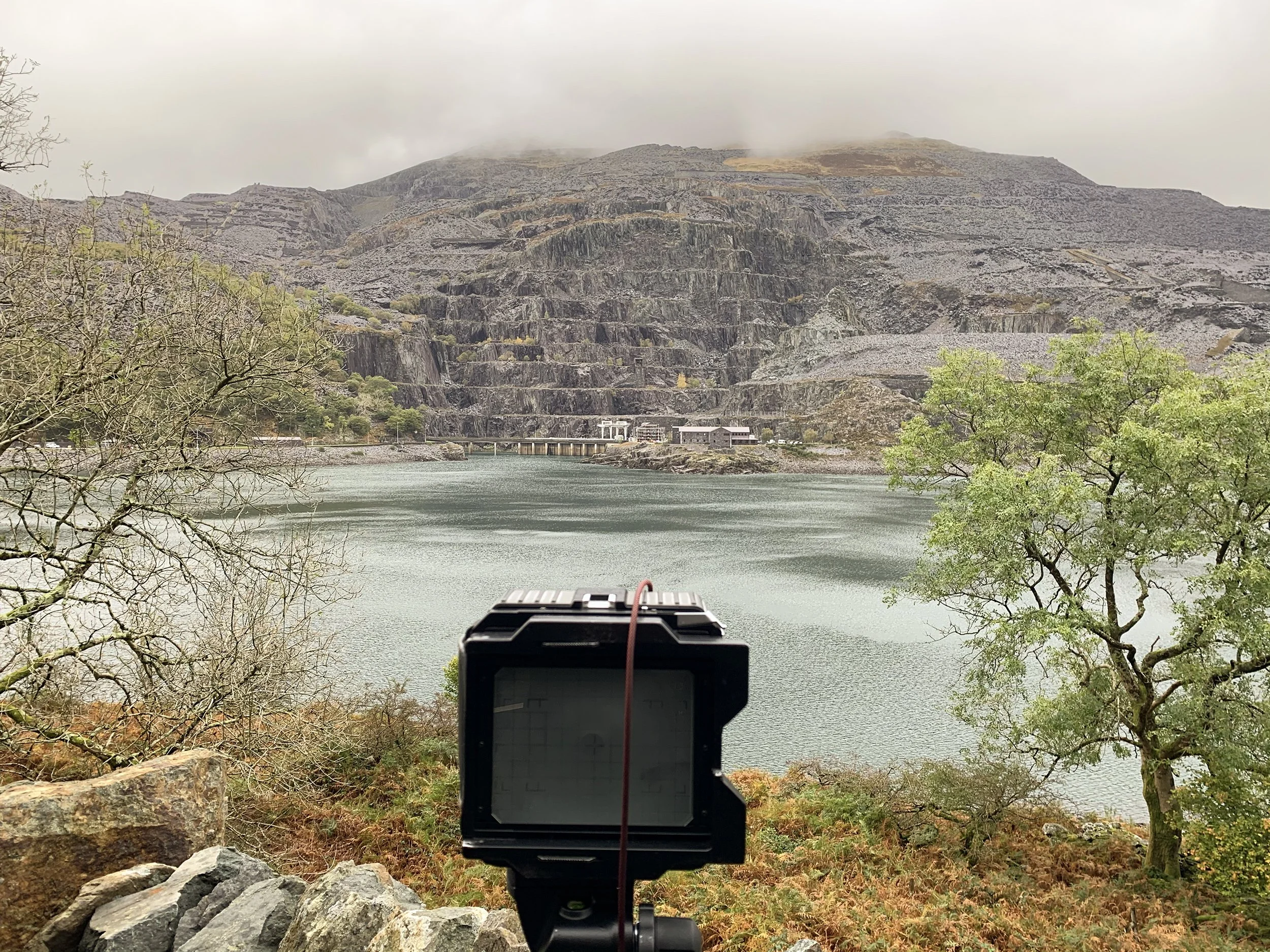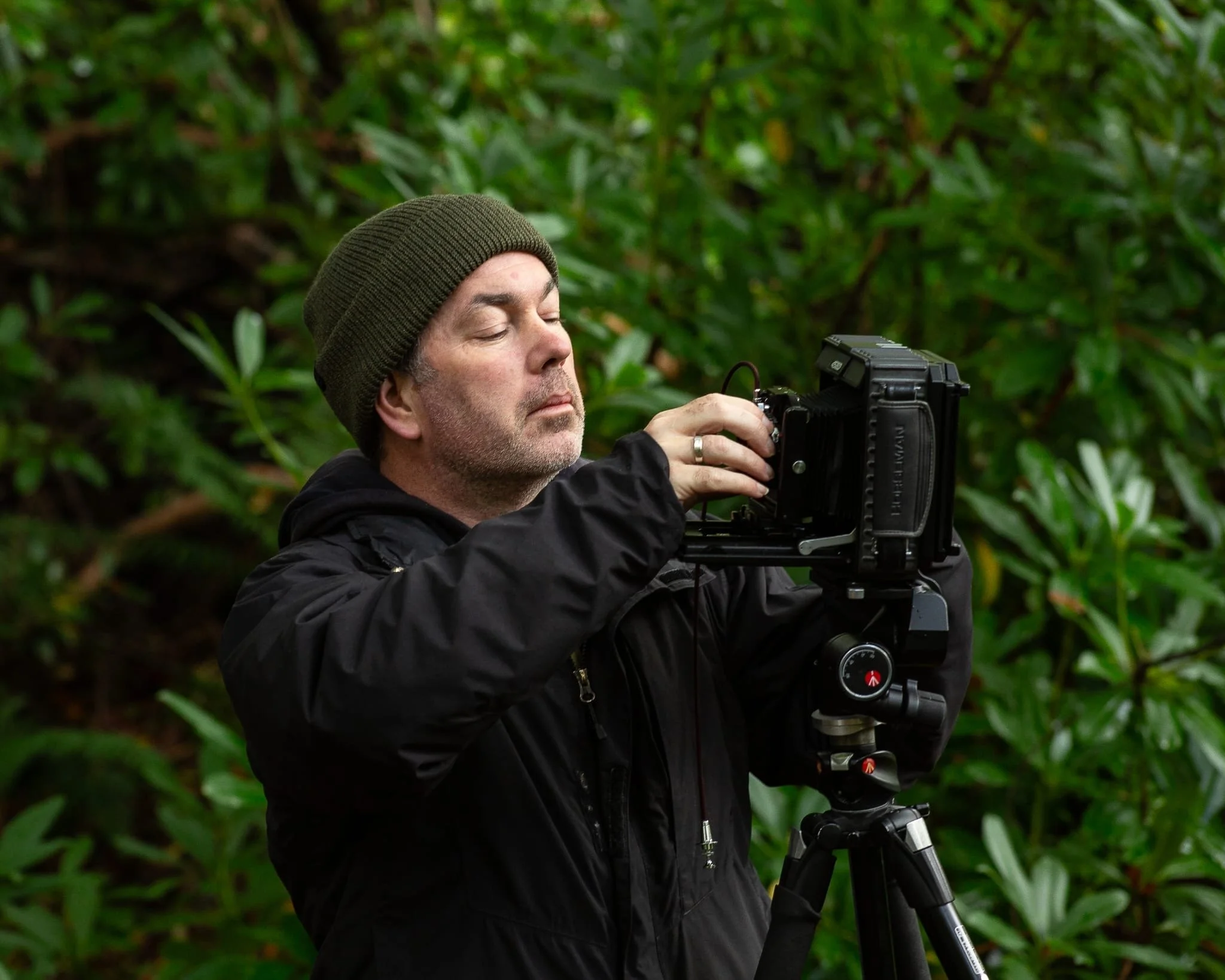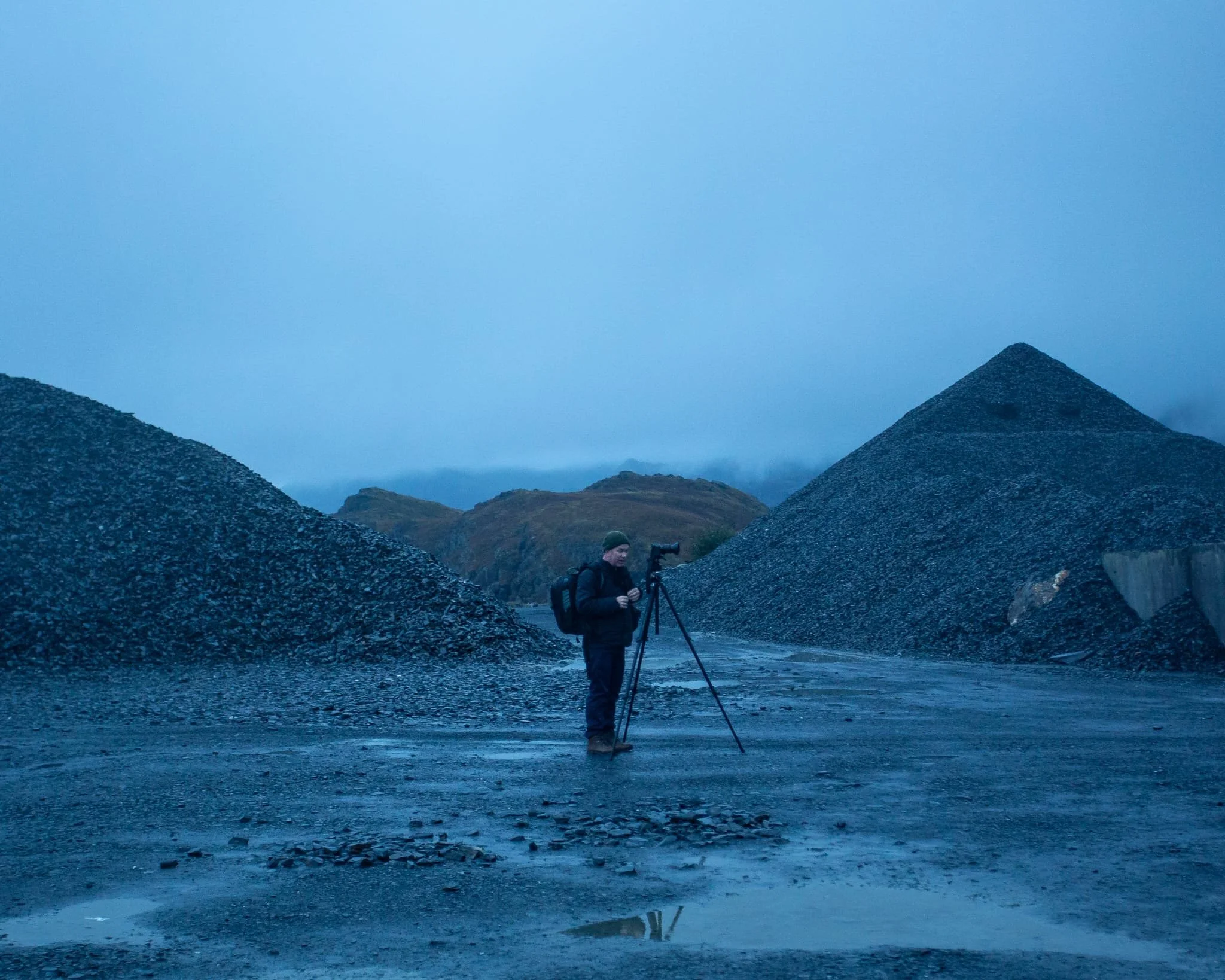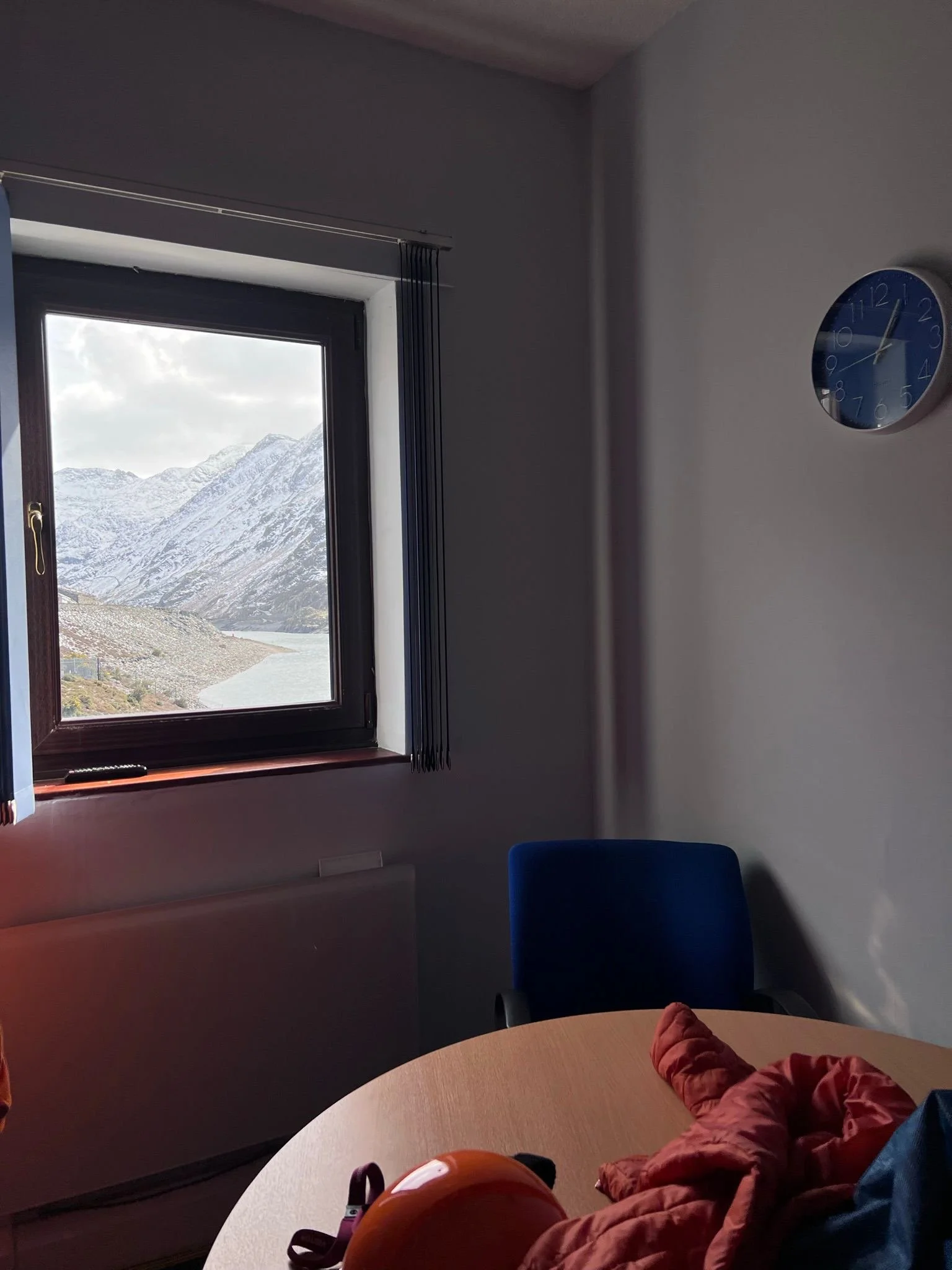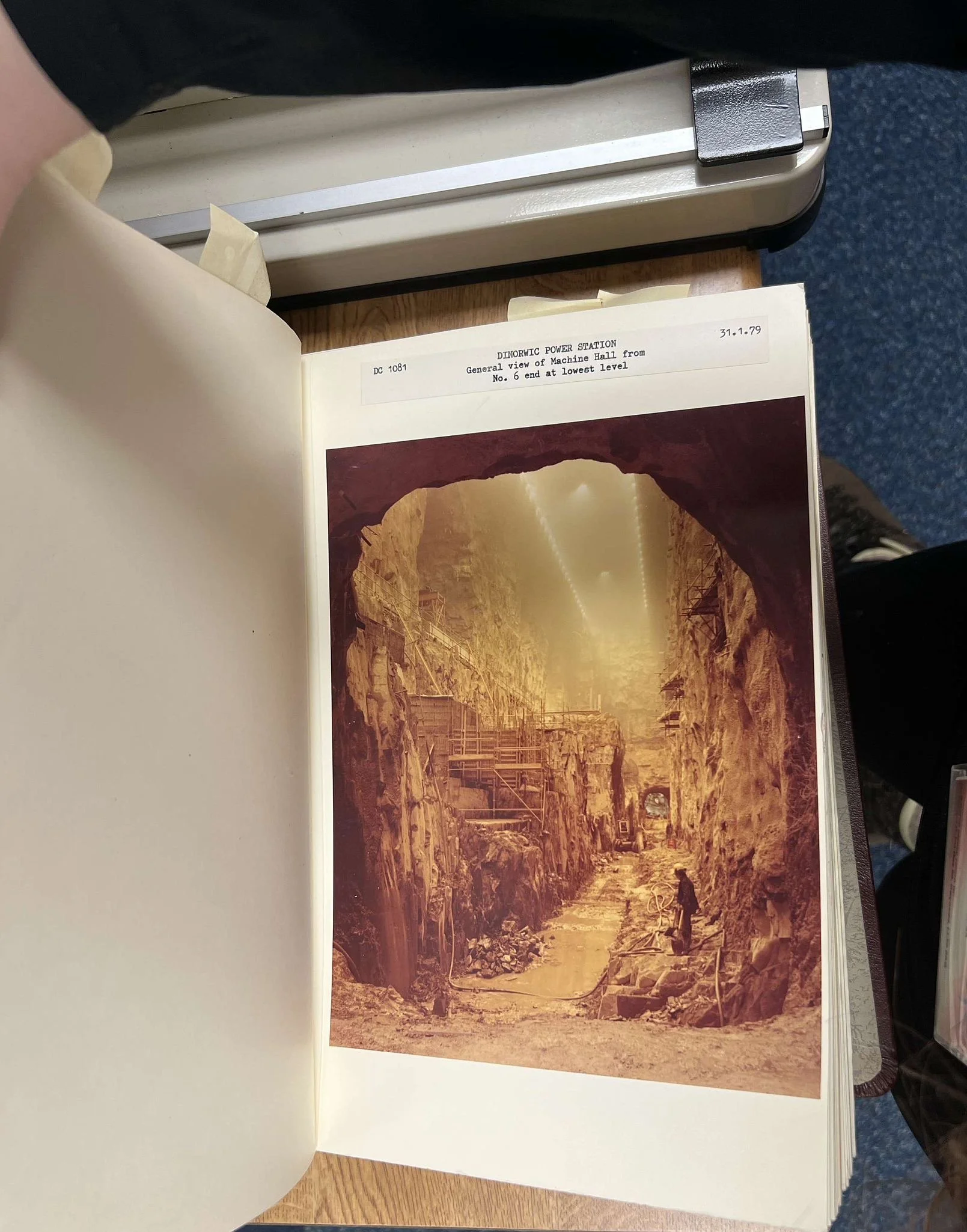Wales: A Diary Archive
This archive is a look into the collaborative spirit and shared inspirations that unite the MAP6 collective – unseen threads that connect the work during the making of Wales: The Landscape Project. It is a glimpse into our creative process, including research and planning notes, and candid snapshots of our experiences and interactions that shaped the work.
The Dark Sublime
Rich Cutler
Four MAP6 members rented a cottage in Blaenau Ffestioniog in north Wales for a week one October. It was the wettest, foggiest place I've been – a strange landscape of waste slate and ruined, abandoned mines that brought to mind Mordor from Lord of the Rings. It was fantastic!
Barry, Chloe and I were collaborating to create a photo zine on the ‘dark sublime’ – the sublime is being awed by the beauty of the world around us, this is its flip side, being terrified and fearful. Richard was exploring quarries, alongside David – not staying with us – who was photographing chapels.
I always look forward to going away with MAP6, and the camaraderie, sharing of ideas and support that's always there. It strengthens my photography and helps me to better understand the world around me. Too often photography is a solitary endeavour, and you feel unsure of yourself.
Rich on location
Lone tree on a quarry ledge
Experimenting with smoke and water in a stream
Local working quarries
Props and photo list made in preparation for the trip
Rich using a helium balloon and a white dress to create images in an abandoned mine
Barry Falk in Denbigh
Montage of exhibition ideas by Barry for ‘common ground’
Barry Falk
For Wales: The Landscape Project we decided to split the collective into groups to explore aspects of the Welsh landscape. Four of us stayed in Ffestiniog, as we'd all decided to photograph in this area. Three of us – including me - were working on the joint theme of the dark sublime – looking for the Gothic in the landscape, seeking places of ambiguity and uncanniness.
I went to Denbigh. This grew out my fascination with Victorian asylums and the memory they still held in their surrounding area. I focused upon the area around the North Wales Hospital in Denbigh, curious to explore its inextricable link with the town through local memory and the landscape.
Meanwhile, Chloe Lelliot explored abandoned slate mines, seeking the abyss, and Rich Cutler constructed images in the post-industrial landscape of an abandoned slate mine to explore local folklore. In the evening we compared our images, forming a sense of overlapping themes. My work adapted to our joint conversations and image sharing. Often it informed the next day’s shoot, for me leading to a darkening of my images, going out to shoot at dusk and embracing the gloom.
Clwyd, Dafyd, Bob and Clwyd, former nurses at Denbigh Hospital
Chloe Lelliot
We began the trip by traveling to Wales together and then staying in the same cottage – Rich Cutler revealed the amount of napalm he had bought and various props needed for his shoots! Most nights ended with fish and chips and the pub. We would look at each others’ images and discuss where our different personal projects were going and how ours would fit together.
Raincoats and comfy shoes were essentials. A long hike up a hill in torrential rain ended with the magical Cwmorthin lake. There was mist clinging everywhere and no one around. In between downpours I shot.
I worked with Richard Chivers for a day. The weather was dramatic like the landscapes, with big showers of rain then sunshine. It changed a lot. We walked around Dinorwig together, going off individually and then coming back to have a chat - giving each other enough space and time to get the shots we both wanted.
I also worked with Rich Cutler setting up scenes in hills of waste slate or working inside empty dilapidated buildings – like something out of Tarkovsky’s Stalker. This was a great break from walking, and it was interesting to see how Rich works.
Rich Cutler and Richard Chivers at the Ffestiniog cottage
Chloe on location
Overflowing river from heavy rain, at the foot of a quarry
Supper at a local takeaway near the Ffestiniog cottage
Jigsaw found at a local charity shop
Parallel Time
Paul Walsh
Ordinarily I work closely with other MAP6 members, staying together and venturing out as a group. This project was solitary however, and I spent two weeks walking alone with my tent across North Wales. The weather made things a challenge with relentless wind and rain; I spent most of the time with soggy boots.
Leading up to the trip my mother passed away. I was devastated. I needed to walk alone and try to come to terms with the situation. As a result, the images I made are an extension of that physical/thought process, and are amongst my darkest and most personal.
At the start of my walk I met with a local historian, who explained the history and industrial archaeology of the area. This helped me to connect with the place. Along the way I also met with people involved with trying to revive the pilgrimage route, who advised me on places to look out for.
My collaboration with Mitch Karunaratne existed from the beginning, and early on we decided to make work about time and the landscape. It was Mitch who gave me the starting point to walk a pilgrimage route across North Wales. Throughout we kept in contact over the phone or via WhatsApp, sharing thoughts and experiences. Upon return we met and edited both sets of images together in a way that could work as a zine. Over the following months we refined the sequence, and recently via Zoom we created the initial layout for our work in this exhibition.
Making images at Aber Falls
The start of Paul’s walk at Greenfield Dock
Paul alone in his tent at night, somewhere near Bangor
Climbing Snowdon, a minor deviation from the trail
Paul after reaching the summit of Snowdon, cold with little visibility
Paul and Mitch sequencing images for Parallel Time
Mitch Karunaratne
Paul and I shared a sense of loss and a need to feel grounded. This was the starting point for this work – helping each other find ways to anchor, to remember and to reconnect.
It was a different project for us. The lack of physical proximity whilst we made the work worried me at first. For all of our other MAP6 projects we’ve been in the same place at the same time working together. But somehow this project feels like the closest we’ve ever worked. Paul is in every one of my images. He was in my head as I faced my fears underground (I’m claustrophobic!) and I was deeply conscious of the journey he was mapping above.
It seems to me when looking at these photos that neither mine nor Paul’s work could have been made without the other. It’s a project we’re both proud to own in its entirety.
And it is the one and only time I’ve slept in a Post Office and had my breakfast just before the counter opens for business!
Cave entrance
Mitch having breakfast at the local post office
Arrows leading the way whilst looking for a cave entrance
Mitch on location in Wales
Cave elevation charts
Hiraeth
Aaron Yeandle
The trip to Wales marked my first adventure with the MAP6 collective. Most of the MAP6 group travelled to North Wales to work on their collaborative projects. At that point, I had not met any of the members of the collective, as I was its newest addition. I was eager to explore Wales and, hopefully, create a compelling body of work.
Before the trip, Heather and I collaborated through online meetings, brainstorming ideas for our project in Wales. We decided to focus on the off-grid communities thriving in the Welsh countryside.
We travelled hundreds of miles through the lush and rainy Welsh countryside in mid-October, supporting each other through what felt like a fool’s errand. Despite the setbacks, we persevered and eventually found off-grid communities willing to let us photograph them.
By the end of the week, we were completely exhausted, feeling as though we had been on a grand Welsh odyssey. However, through our positive collaboration, we managed to create a beautiful body of work – a result that might not have been possible without the teamwork and perseverance that Heather and I demonstrated, pushing each other to keep going even when it seemed like our trip and the project were on the verge of falling apart.
Aaron sharing images
Heather Shuker
The premise of a MAP6 project is that members visit the same location (for the Wales project - the same country) and make work over a set time period – though as a portrait and documentary photographer, working within a limited time period can be challenging.
For this project I teamed up fellow portrait photographer Aaron, and before we settled on “living off grid” we brainstormed many ideas connecting people and the land in Wales. We had to be realistic about what was possible at the tail end of the pandemic, and decided that visiting around five communities could make a project. However two days before starting the project we only had two people who willing to meet with us, and neither had agreed to have their photographs taken.
We considered cancelling the trip as it felt like a wild goose chase. If I was working solo I am sure I would have given up, but collaborating with each other gave us confidence to head to Wales and, well, just wing it!
In the end we photographed six families/communities and drove around 700 miles, booked B&Bs on the fly and slept in a van, and ate too many cheese and pickle sandwiches. However, considering the challenges, we made enough material to win places in the Portrait of Britain, publish our zine and curate works for the Brighton Photo Fringe.
Messaging between Heather and Aaron
With Gina and Tina, Owensfield, the Gower Peninsula
Flood warnings
Heather Shuker on location in Wales
Routes across south Wales for off-grid communities
Flooding, causing severe road closures
Chapels and Quarries
David Sterry
Whilst at architecture school in Cardiff nearly 50 years ago, we were sent out to draw chapels in the context of their industrial landscape and the communities they served. It was something of a homecoming to visit some of those chapels again.
I contacted the guardians of 10 chapels across Wales to arrange access. I was met at each chapel, and learnt of their struggle to preserve these significant buildings. Some were still working, but most are now redundant. I drove down almost impassable tracks to remote chapels and ran the gauntlet of running out of petrol in the Brecon Beacons. It poured with rain very day.
Where my chapel images are small and dark and echo their sombre history, Richard’s reflect the sheer scale and magnitude of slate quarries. He and I photographed our subjects separately but in the knowledge that together they made a perfect collaborative project.
David on the road across Wales
Chapel interiors and backrooms
Visiting a small, well-preserved chapel
Research and a route map for David journey
Richard Chivers
I collaborated with David Sterry on this project – from the outset we knew we would be working towards making a zine. David was very keen on capturing the chapels of Wales, so I decided I would photograph slate quarries in North Wales. Both the chapels and quarries came to prominence at a similar time, and often the chapels were built to serve the communities that sprung up around the slate industry. I was interested in how the this industry had changed the Welsh landscape forever, how it had been shaped and re-shaped over time. So four members of MAP6 hired an old workers cottage in Ffestiniog – the heart of the slate industry: myself, Chloe Lelliott, Rich Cutler and Barry Falk.
As well as making my own work I spent time with the three other members of MAP6 who were each making their own projects. I spent a day in a slate mine with Rich Cutler, helping him to set fire to a floating dress; Chloe and I went to Dinorwic quarry; and Barry Falk came with me to Dorothea Quarry. Each evening we would share our photos at our cottage and talk about ideas and problems we were having. It was a great way to make work – having other people to share ideas with. It was also a learning curve seeing how other members of the group worked.
Quarry near to Llanberis
Richard’s 5x4 camera
Richard on location
A cold morning working at a quarry
Battery in the Mountain
Leia Ankers
I experienced this feeling of intimidation when shooting at Dinorwig Power Station, due to the its magnitude and complexity. Looking across the misty lake and seeing a building poking out of the mountain, it all felt dreamlike; it seemed like the building had been copied and pasted into the landscape. I felt mesmerised by the sight and intrigued by its mystery. There was something haunting about the atmosphere. Once inside it was a labyrinth, with many levels all coded with different colours, and the caverns had its own traffic light system. It all heightened the smallness of human experience. I felt far removed from the outside world. I was amazed by the contrast between the clean and clinical man-made features of technology in comparison to the overgrown stamp of nature on the surface.
MAP6 invited me to be part of the curation team for our exhibition in Photo Fringe 2024, and together we worked towards a shared goal of how to include aspects of its theme ‘common ground’. This collaboration provided a space to share ideas, insights and overcome challenges – encouraging openness and a sense of connection through common interests of curation. This was achieved through shared documents the entire collective could edit, and made feedback easier for us all. As well, there were group chats and video calls, allowing the curation team and MAP6 as a whole and to keep track of suggestions and developments.
Entrance to the headwork tunnels
On location at Blaenau Ffestiniog Power Station
Inside Dinorwig Power Station offices
Archive images from Dinorwig Power Station


